Team Based Creativity and Innovation for Torus Games
VerifiedAdded on 2023/06/04
|20
|4239
|400
AI Summary
The report presents creative solutions to mitigate employee management issues at Torus Games. It explores the innovative solutions to employee stress, de-motivation, project timeline crunch, lack of work-life balance, and mass turnover. The report discusses brainstorming, six thinking hats, and visual collaboration techniques used to generate ideas and evaluate them. It also presents the best solutions to the identified issues, including auditing, employee socialisation, automating game-play and level testing, and back up with a reduced feature set of the game.
Contribute Materials
Your contribution can guide someone’s learning journey. Share your
documents today.
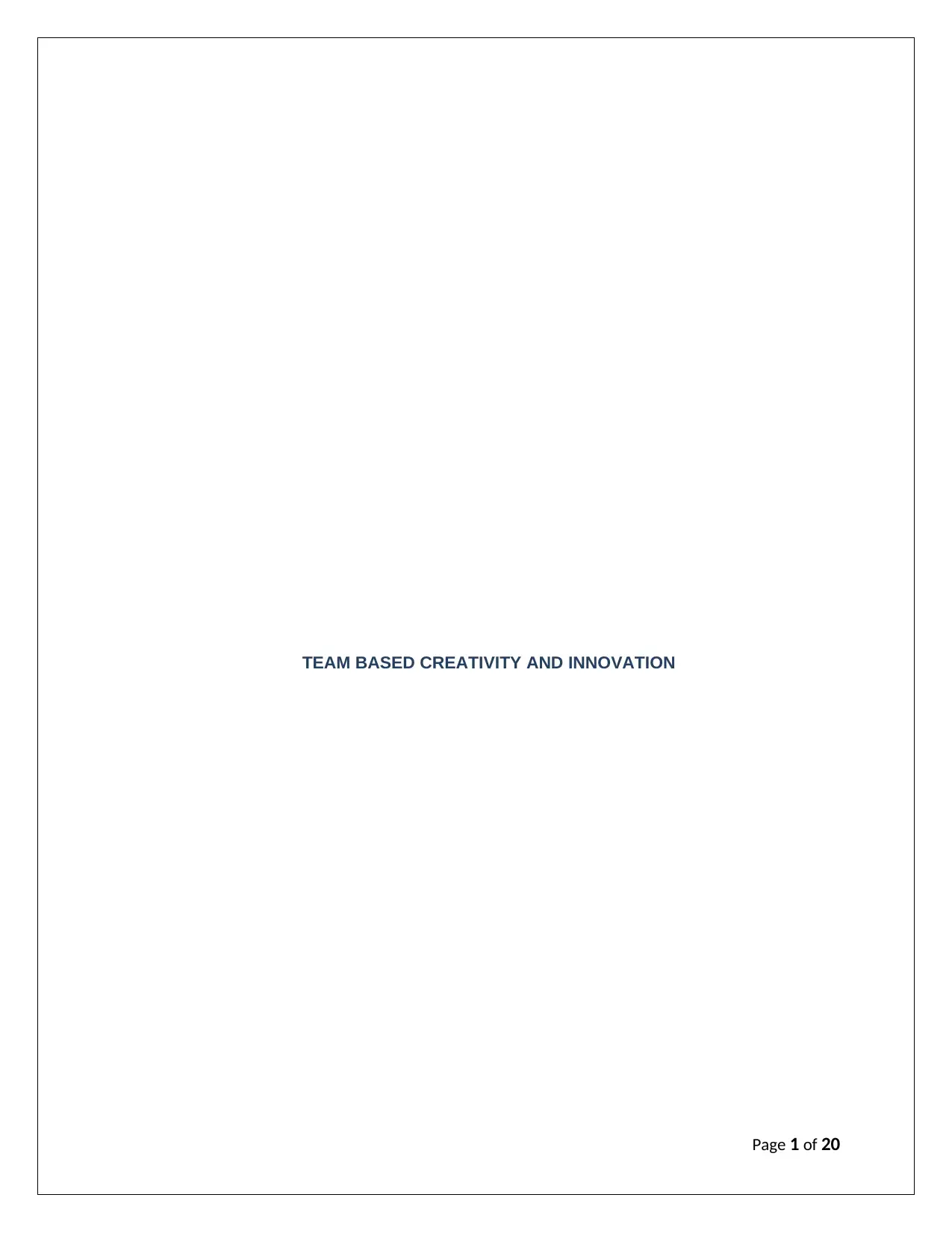
TEAM BASED CREATIVITY AND INNOVATION
Page 1 of 20
Page 1 of 20
Secure Best Marks with AI Grader
Need help grading? Try our AI Grader for instant feedback on your assignments.
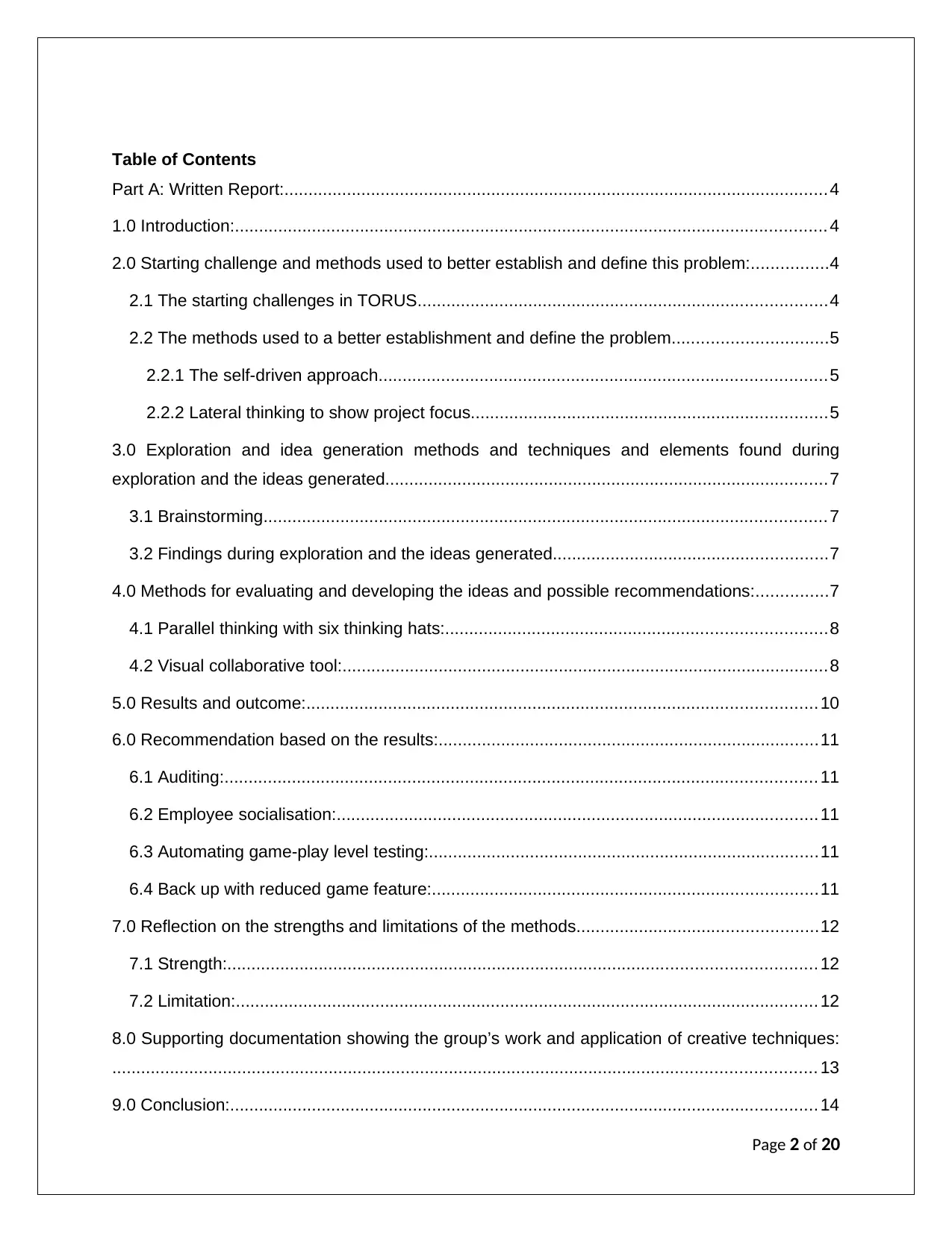
Table of Contents
Part A: Written Report:.................................................................................................................4
1.0 Introduction:........................................................................................................................... 4
2.0 Starting challenge and methods used to better establish and define this problem:................4
2.1 The starting challenges in TORUS.....................................................................................4
2.2 The methods used to a better establishment and define the problem................................5
2.2.1 The self-driven approach.............................................................................................5
2.2.2 Lateral thinking to show project focus..........................................................................5
3.0 Exploration and idea generation methods and techniques and elements found during
exploration and the ideas generated............................................................................................7
3.1 Brainstorming..................................................................................................................... 7
3.2 Findings during exploration and the ideas generated.........................................................7
4.0 Methods for evaluating and developing the ideas and possible recommendations:...............7
4.1 Parallel thinking with six thinking hats:...............................................................................8
4.2 Visual collaborative tool:.....................................................................................................8
5.0 Results and outcome:..........................................................................................................10
6.0 Recommendation based on the results:...............................................................................11
6.1 Auditing:........................................................................................................................... 11
6.2 Employee socialisation:....................................................................................................11
6.3 Automating game-play level testing:.................................................................................11
6.4 Back up with reduced game feature:................................................................................11
7.0 Reflection on the strengths and limitations of the methods..................................................12
7.1 Strength:.......................................................................................................................... 12
7.2 Limitation:......................................................................................................................... 12
8.0 Supporting documentation showing the group’s work and application of creative techniques:
.................................................................................................................................................. 13
9.0 Conclusion:.......................................................................................................................... 14
Page 2 of 20
Part A: Written Report:.................................................................................................................4
1.0 Introduction:........................................................................................................................... 4
2.0 Starting challenge and methods used to better establish and define this problem:................4
2.1 The starting challenges in TORUS.....................................................................................4
2.2 The methods used to a better establishment and define the problem................................5
2.2.1 The self-driven approach.............................................................................................5
2.2.2 Lateral thinking to show project focus..........................................................................5
3.0 Exploration and idea generation methods and techniques and elements found during
exploration and the ideas generated............................................................................................7
3.1 Brainstorming..................................................................................................................... 7
3.2 Findings during exploration and the ideas generated.........................................................7
4.0 Methods for evaluating and developing the ideas and possible recommendations:...............7
4.1 Parallel thinking with six thinking hats:...............................................................................8
4.2 Visual collaborative tool:.....................................................................................................8
5.0 Results and outcome:..........................................................................................................10
6.0 Recommendation based on the results:...............................................................................11
6.1 Auditing:........................................................................................................................... 11
6.2 Employee socialisation:....................................................................................................11
6.3 Automating game-play level testing:.................................................................................11
6.4 Back up with reduced game feature:................................................................................11
7.0 Reflection on the strengths and limitations of the methods..................................................12
7.1 Strength:.......................................................................................................................... 12
7.2 Limitation:......................................................................................................................... 12
8.0 Supporting documentation showing the group’s work and application of creative techniques:
.................................................................................................................................................. 13
9.0 Conclusion:.......................................................................................................................... 14
Page 2 of 20
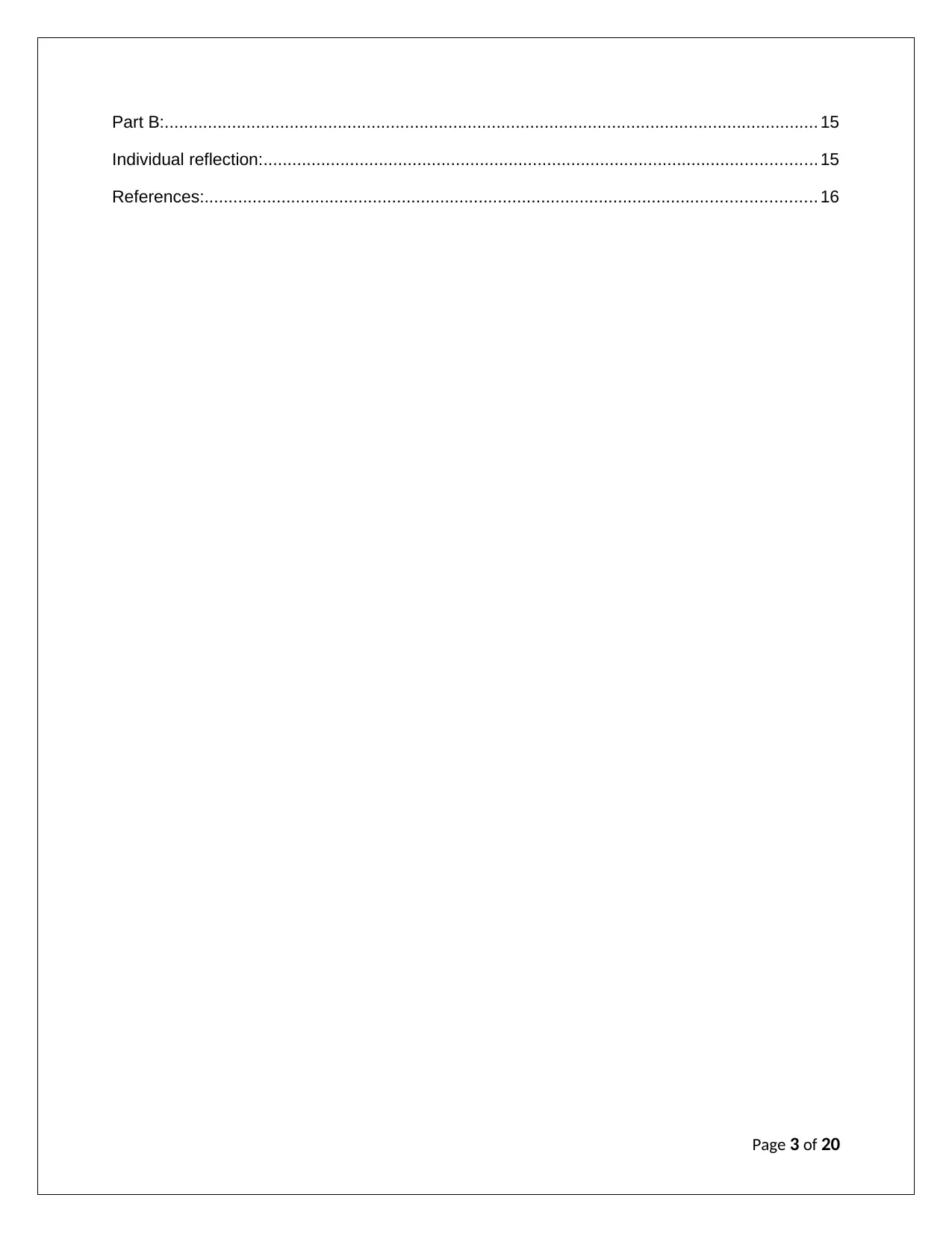
Part B:........................................................................................................................................ 15
Individual reflection:................................................................................................................... 15
References:............................................................................................................................... 16
Page 3 of 20
Individual reflection:................................................................................................................... 15
References:............................................................................................................................... 16
Page 3 of 20
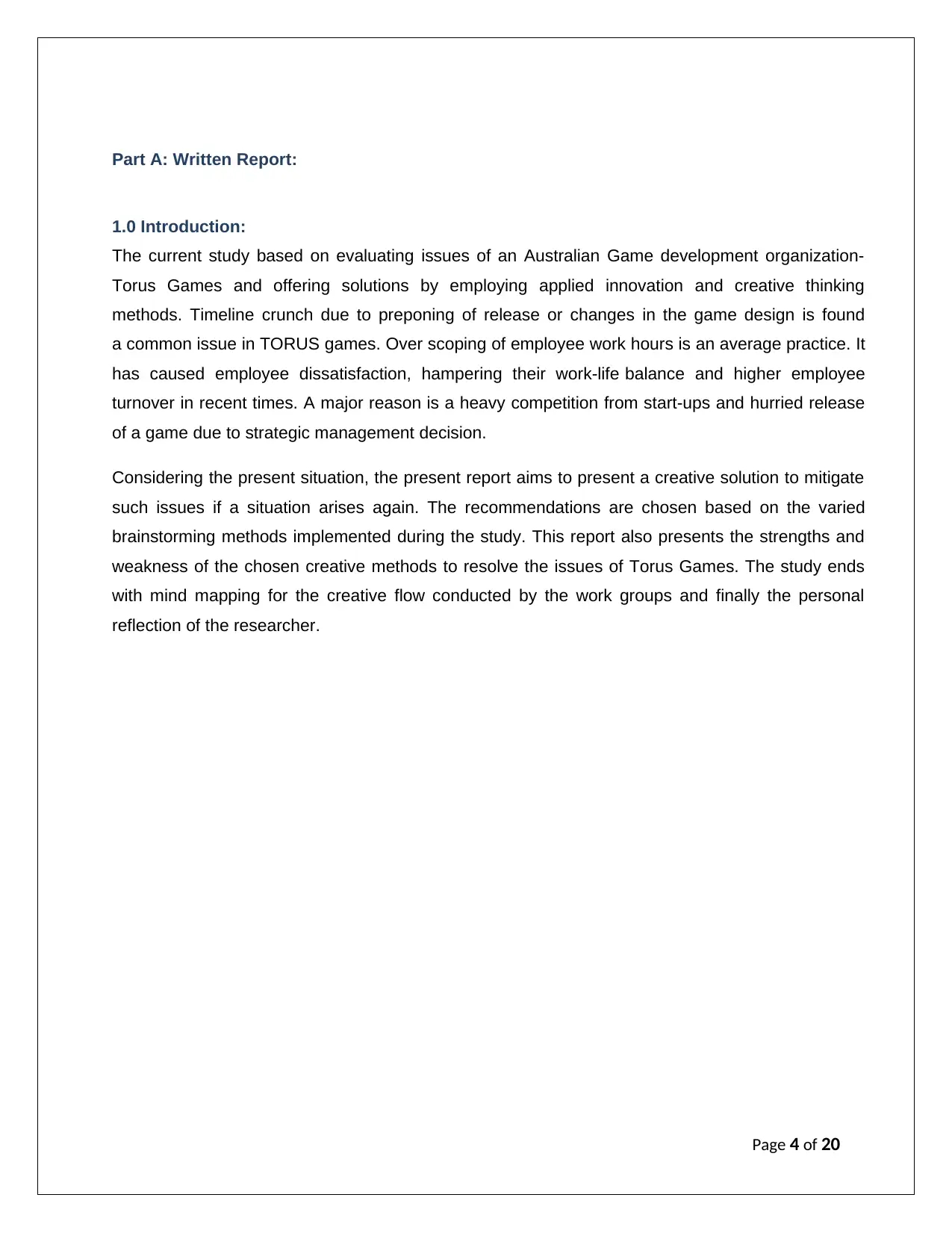
Part A: Written Report:
1.0 Introduction:
The current study based on evaluating issues of an Australian Game development organization-
Torus Games and offering solutions by employing applied innovation and creative thinking
methods. Timeline crunch due to preponing of release or changes in the game design is found
a common issue in TORUS games. Over scoping of employee work hours is an average practice. It
has caused employee dissatisfaction, hampering their work-life balance and higher employee
turnover in recent times. A major reason is a heavy competition from start-ups and hurried release
of a game due to strategic management decision.
Considering the present situation, the present report aims to present a creative solution to mitigate
such issues if a situation arises again. The recommendations are chosen based on the varied
brainstorming methods implemented during the study. This report also presents the strengths and
weakness of the chosen creative methods to resolve the issues of Torus Games. The study ends
with mind mapping for the creative flow conducted by the work groups and finally the personal
reflection of the researcher.
Page 4 of 20
1.0 Introduction:
The current study based on evaluating issues of an Australian Game development organization-
Torus Games and offering solutions by employing applied innovation and creative thinking
methods. Timeline crunch due to preponing of release or changes in the game design is found
a common issue in TORUS games. Over scoping of employee work hours is an average practice. It
has caused employee dissatisfaction, hampering their work-life balance and higher employee
turnover in recent times. A major reason is a heavy competition from start-ups and hurried release
of a game due to strategic management decision.
Considering the present situation, the present report aims to present a creative solution to mitigate
such issues if a situation arises again. The recommendations are chosen based on the varied
brainstorming methods implemented during the study. This report also presents the strengths and
weakness of the chosen creative methods to resolve the issues of Torus Games. The study ends
with mind mapping for the creative flow conducted by the work groups and finally the personal
reflection of the researcher.
Page 4 of 20
Secure Best Marks with AI Grader
Need help grading? Try our AI Grader for instant feedback on your assignments.
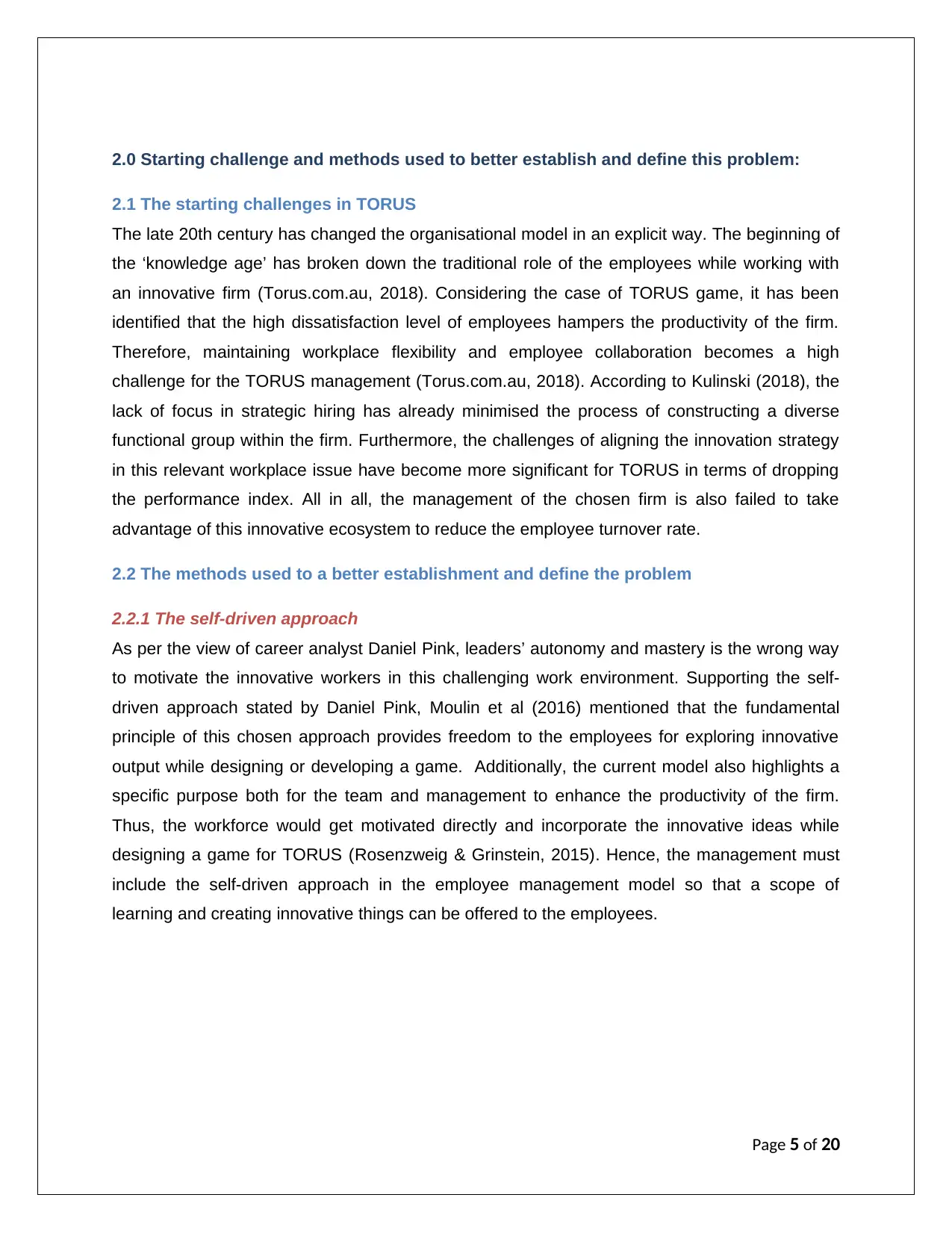
2.0 Starting challenge and methods used to better establish and define this problem:
2.1 The starting challenges in TORUS
The late 20th century has changed the organisational model in an explicit way. The beginning of
the ‘knowledge age’ has broken down the traditional role of the employees while working with
an innovative firm (Torus.com.au, 2018). Considering the case of TORUS game, it has been
identified that the high dissatisfaction level of employees hampers the productivity of the firm.
Therefore, maintaining workplace flexibility and employee collaboration becomes a high
challenge for the TORUS management (Torus.com.au, 2018). According to Kulinski (2018), the
lack of focus in strategic hiring has already minimised the process of constructing a diverse
functional group within the firm. Furthermore, the challenges of aligning the innovation strategy
in this relevant workplace issue have become more significant for TORUS in terms of dropping
the performance index. All in all, the management of the chosen firm is also failed to take
advantage of this innovative ecosystem to reduce the employee turnover rate.
2.2 The methods used to a better establishment and define the problem
2.2.1 The self-driven approach
As per the view of career analyst Daniel Pink, leaders’ autonomy and mastery is the wrong way
to motivate the innovative workers in this challenging work environment. Supporting the self-
driven approach stated by Daniel Pink, Moulin et al (2016) mentioned that the fundamental
principle of this chosen approach provides freedom to the employees for exploring innovative
output while designing or developing a game. Additionally, the current model also highlights a
specific purpose both for the team and management to enhance the productivity of the firm.
Thus, the workforce would get motivated directly and incorporate the innovative ideas while
designing a game for TORUS (Rosenzweig & Grinstein, 2015). Hence, the management must
include the self-driven approach in the employee management model so that a scope of
learning and creating innovative things can be offered to the employees.
Page 5 of 20
2.1 The starting challenges in TORUS
The late 20th century has changed the organisational model in an explicit way. The beginning of
the ‘knowledge age’ has broken down the traditional role of the employees while working with
an innovative firm (Torus.com.au, 2018). Considering the case of TORUS game, it has been
identified that the high dissatisfaction level of employees hampers the productivity of the firm.
Therefore, maintaining workplace flexibility and employee collaboration becomes a high
challenge for the TORUS management (Torus.com.au, 2018). According to Kulinski (2018), the
lack of focus in strategic hiring has already minimised the process of constructing a diverse
functional group within the firm. Furthermore, the challenges of aligning the innovation strategy
in this relevant workplace issue have become more significant for TORUS in terms of dropping
the performance index. All in all, the management of the chosen firm is also failed to take
advantage of this innovative ecosystem to reduce the employee turnover rate.
2.2 The methods used to a better establishment and define the problem
2.2.1 The self-driven approach
As per the view of career analyst Daniel Pink, leaders’ autonomy and mastery is the wrong way
to motivate the innovative workers in this challenging work environment. Supporting the self-
driven approach stated by Daniel Pink, Moulin et al (2016) mentioned that the fundamental
principle of this chosen approach provides freedom to the employees for exploring innovative
output while designing or developing a game. Additionally, the current model also highlights a
specific purpose both for the team and management to enhance the productivity of the firm.
Thus, the workforce would get motivated directly and incorporate the innovative ideas while
designing a game for TORUS (Rosenzweig & Grinstein, 2015). Hence, the management must
include the self-driven approach in the employee management model so that a scope of
learning and creating innovative things can be offered to the employees.
Page 5 of 20
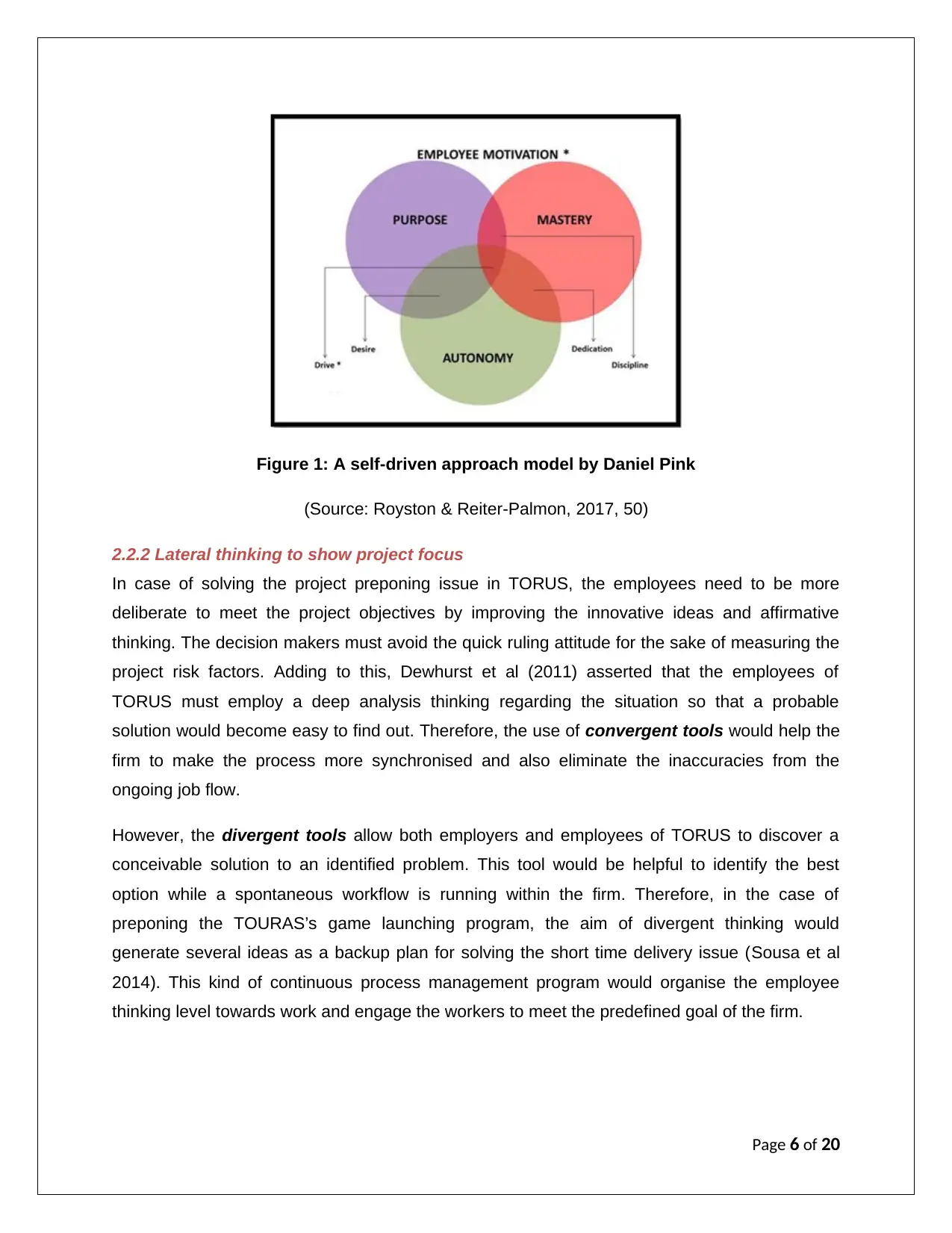
Figure 1: A self-driven approach model by Daniel Pink
(Source: Royston & Reiter-Palmon, 2017, 50)
2.2.2 Lateral thinking to show project focus
In case of solving the project preponing issue in TORUS, the employees need to be more
deliberate to meet the project objectives by improving the innovative ideas and affirmative
thinking. The decision makers must avoid the quick ruling attitude for the sake of measuring the
project risk factors. Adding to this, Dewhurst et al (2011) asserted that the employees of
TORUS must employ a deep analysis thinking regarding the situation so that a probable
solution would become easy to find out. Therefore, the use of convergent tools would help the
firm to make the process more synchronised and also eliminate the inaccuracies from the
ongoing job flow.
However, the divergent tools allow both employers and employees of TORUS to discover a
conceivable solution to an identified problem. This tool would be helpful to identify the best
option while a spontaneous workflow is running within the firm. Therefore, in the case of
preponing the TOURAS’s game launching program, the aim of divergent thinking would
generate several ideas as a backup plan for solving the short time delivery issue (Sousa et al
2014). This kind of continuous process management program would organise the employee
thinking level towards work and engage the workers to meet the predefined goal of the firm.
Page 6 of 20
(Source: Royston & Reiter-Palmon, 2017, 50)
2.2.2 Lateral thinking to show project focus
In case of solving the project preponing issue in TORUS, the employees need to be more
deliberate to meet the project objectives by improving the innovative ideas and affirmative
thinking. The decision makers must avoid the quick ruling attitude for the sake of measuring the
project risk factors. Adding to this, Dewhurst et al (2011) asserted that the employees of
TORUS must employ a deep analysis thinking regarding the situation so that a probable
solution would become easy to find out. Therefore, the use of convergent tools would help the
firm to make the process more synchronised and also eliminate the inaccuracies from the
ongoing job flow.
However, the divergent tools allow both employers and employees of TORUS to discover a
conceivable solution to an identified problem. This tool would be helpful to identify the best
option while a spontaneous workflow is running within the firm. Therefore, in the case of
preponing the TOURAS’s game launching program, the aim of divergent thinking would
generate several ideas as a backup plan for solving the short time delivery issue (Sousa et al
2014). This kind of continuous process management program would organise the employee
thinking level towards work and engage the workers to meet the predefined goal of the firm.
Page 6 of 20
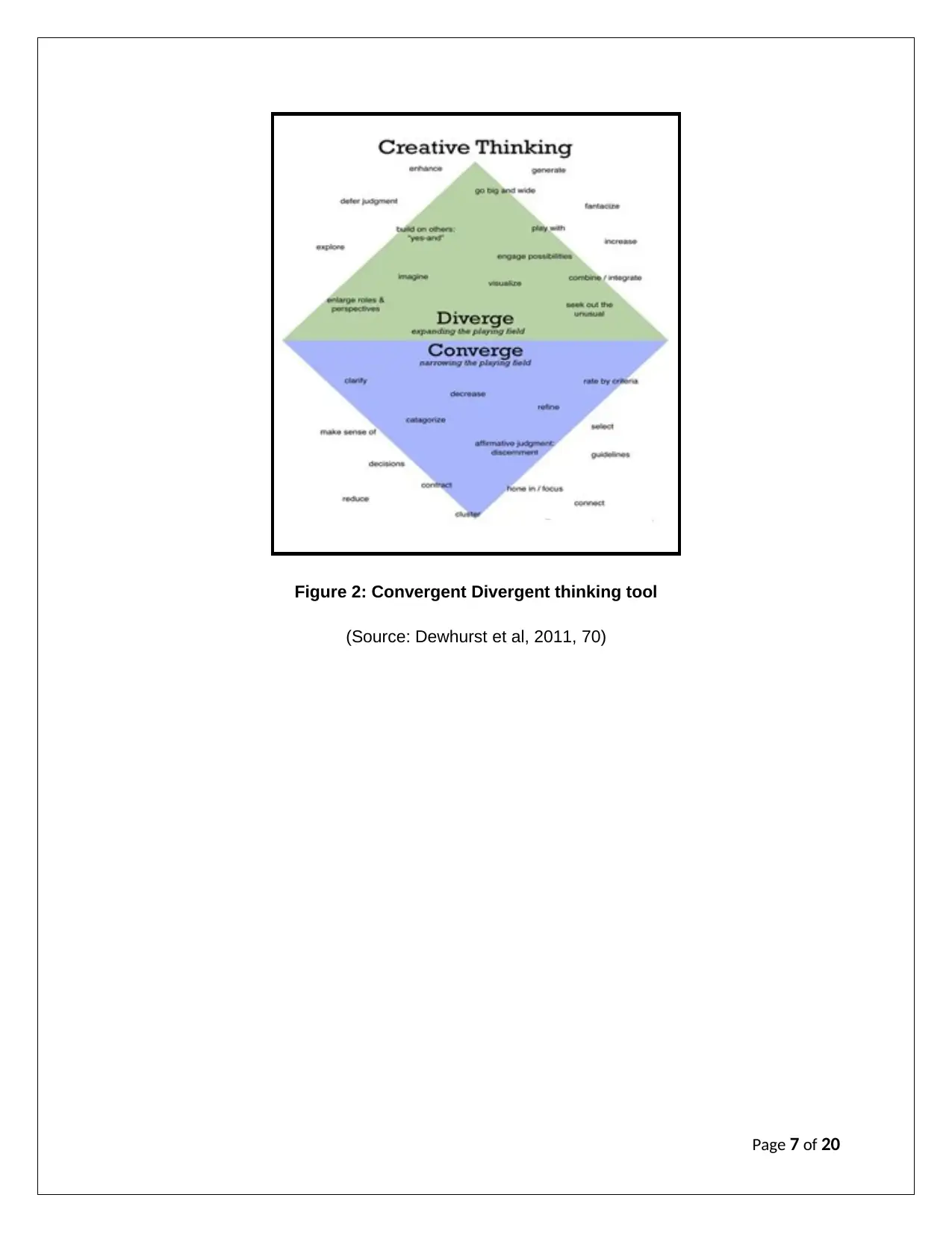
Figure 2: Convergent Divergent thinking tool
(Source: Dewhurst et al, 2011, 70)
Page 7 of 20
(Source: Dewhurst et al, 2011, 70)
Page 7 of 20
Paraphrase This Document
Need a fresh take? Get an instant paraphrase of this document with our AI Paraphraser
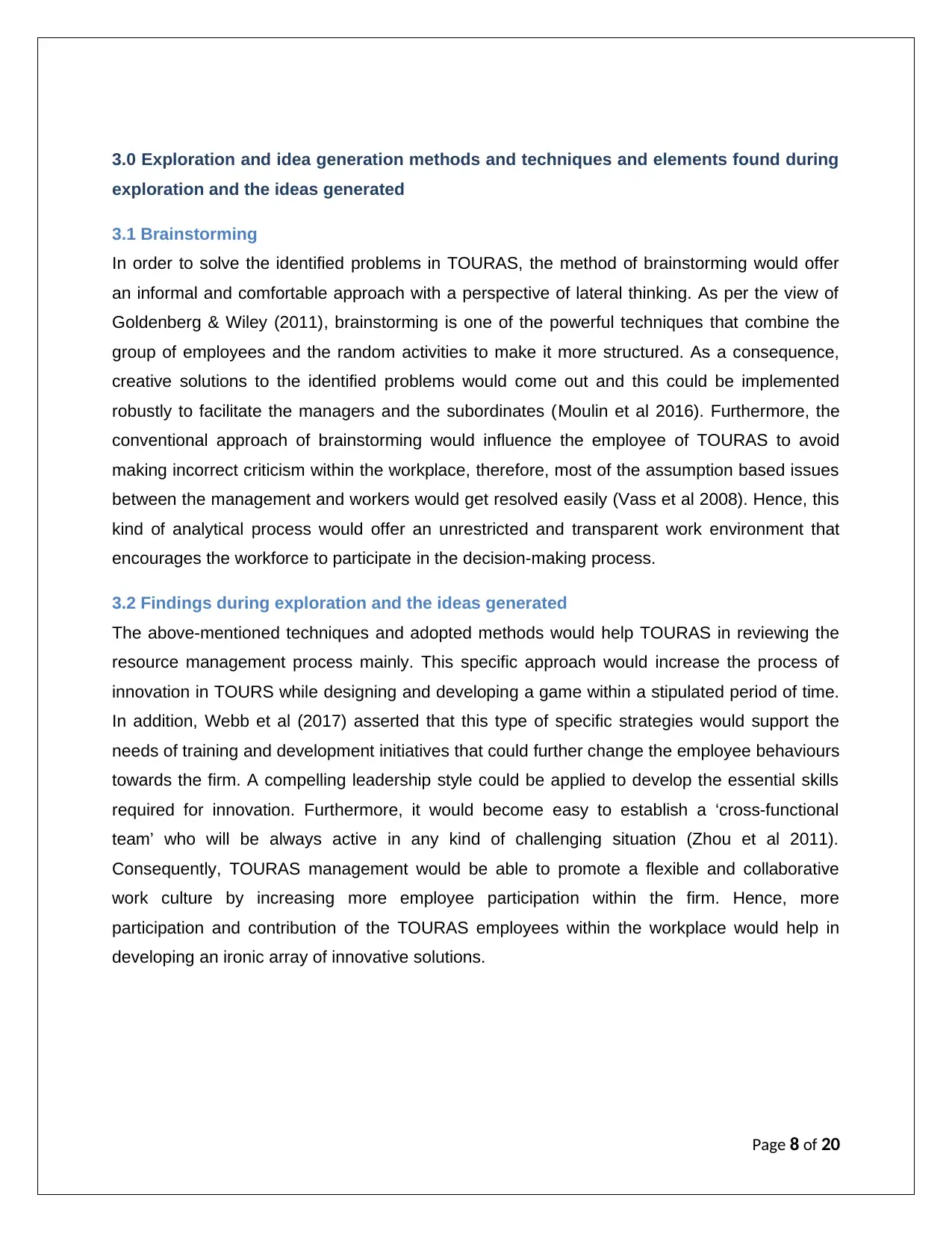
3.0 Exploration and idea generation methods and techniques and elements found during
exploration and the ideas generated
3.1 Brainstorming
In order to solve the identified problems in TOURAS, the method of brainstorming would offer
an informal and comfortable approach with a perspective of lateral thinking. As per the view of
Goldenberg & Wiley (2011), brainstorming is one of the powerful techniques that combine the
group of employees and the random activities to make it more structured. As a consequence,
creative solutions to the identified problems would come out and this could be implemented
robustly to facilitate the managers and the subordinates (Moulin et al 2016). Furthermore, the
conventional approach of brainstorming would influence the employee of TOURAS to avoid
making incorrect criticism within the workplace, therefore, most of the assumption based issues
between the management and workers would get resolved easily (Vass et al 2008). Hence, this
kind of analytical process would offer an unrestricted and transparent work environment that
encourages the workforce to participate in the decision-making process.
3.2 Findings during exploration and the ideas generated
The above-mentioned techniques and adopted methods would help TOURAS in reviewing the
resource management process mainly. This specific approach would increase the process of
innovation in TOURS while designing and developing a game within a stipulated period of time.
In addition, Webb et al (2017) asserted that this type of specific strategies would support the
needs of training and development initiatives that could further change the employee behaviours
towards the firm. A compelling leadership style could be applied to develop the essential skills
required for innovation. Furthermore, it would become easy to establish a ‘cross-functional
team’ who will be always active in any kind of challenging situation (Zhou et al 2011).
Consequently, TOURAS management would be able to promote a flexible and collaborative
work culture by increasing more employee participation within the firm. Hence, more
participation and contribution of the TOURAS employees within the workplace would help in
developing an ironic array of innovative solutions.
Page 8 of 20
exploration and the ideas generated
3.1 Brainstorming
In order to solve the identified problems in TOURAS, the method of brainstorming would offer
an informal and comfortable approach with a perspective of lateral thinking. As per the view of
Goldenberg & Wiley (2011), brainstorming is one of the powerful techniques that combine the
group of employees and the random activities to make it more structured. As a consequence,
creative solutions to the identified problems would come out and this could be implemented
robustly to facilitate the managers and the subordinates (Moulin et al 2016). Furthermore, the
conventional approach of brainstorming would influence the employee of TOURAS to avoid
making incorrect criticism within the workplace, therefore, most of the assumption based issues
between the management and workers would get resolved easily (Vass et al 2008). Hence, this
kind of analytical process would offer an unrestricted and transparent work environment that
encourages the workforce to participate in the decision-making process.
3.2 Findings during exploration and the ideas generated
The above-mentioned techniques and adopted methods would help TOURAS in reviewing the
resource management process mainly. This specific approach would increase the process of
innovation in TOURS while designing and developing a game within a stipulated period of time.
In addition, Webb et al (2017) asserted that this type of specific strategies would support the
needs of training and development initiatives that could further change the employee behaviours
towards the firm. A compelling leadership style could be applied to develop the essential skills
required for innovation. Furthermore, it would become easy to establish a ‘cross-functional
team’ who will be always active in any kind of challenging situation (Zhou et al 2011).
Consequently, TOURAS management would be able to promote a flexible and collaborative
work culture by increasing more employee participation within the firm. Hence, more
participation and contribution of the TOURAS employees within the workplace would help in
developing an ironic array of innovative solutions.
Page 8 of 20
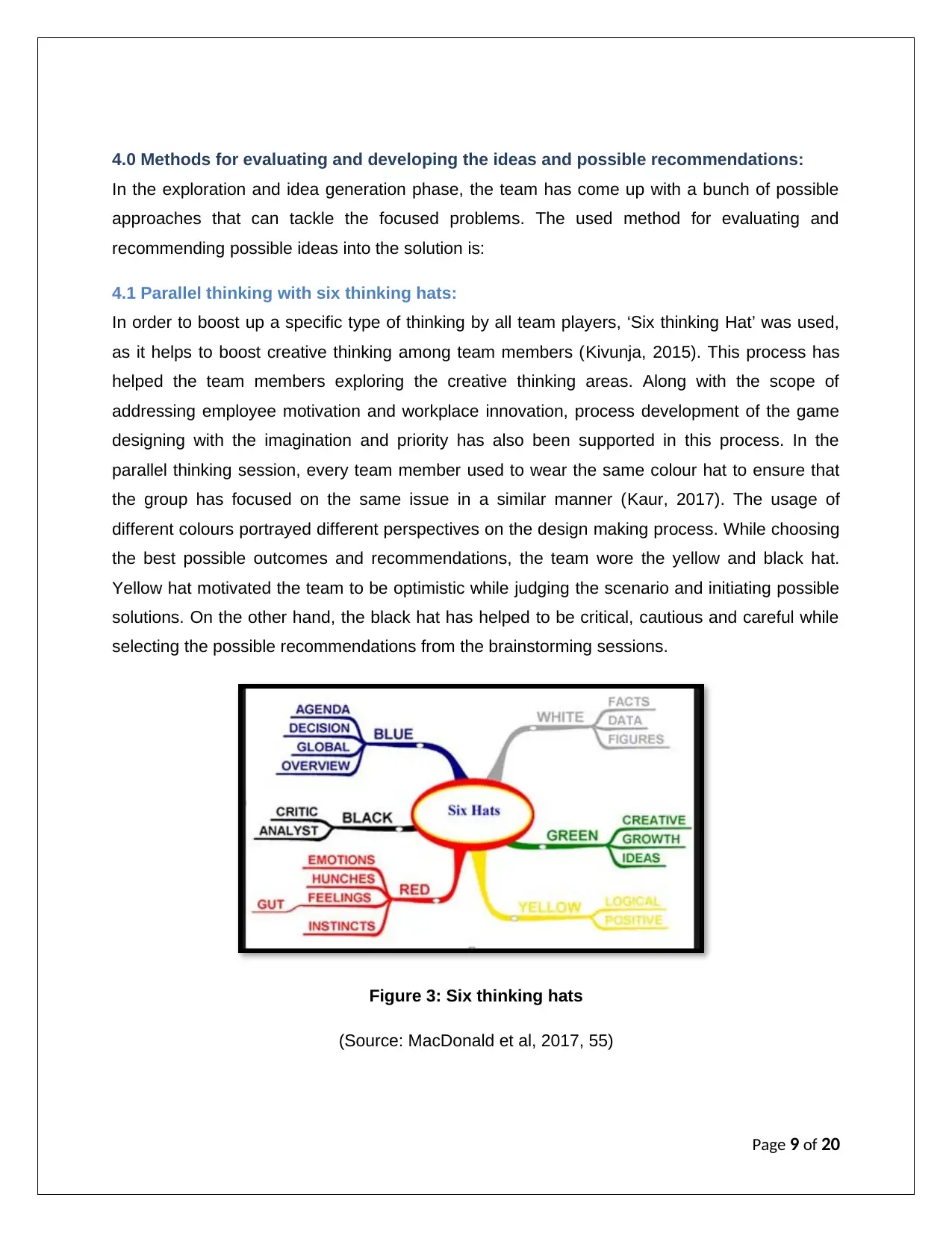
4.0 Methods for evaluating and developing the ideas and possible recommendations:
In the exploration and idea generation phase, the team has come up with a bunch of possible
approaches that can tackle the focused problems. The used method for evaluating and
recommending possible ideas into the solution is:
4.1 Parallel thinking with six thinking hats:
In order to boost up a specific type of thinking by all team players, ‘Six thinking Hat’ was used,
as it helps to boost creative thinking among team members (Kivunja, 2015). This process has
helped the team members exploring the creative thinking areas. Along with the scope of
addressing employee motivation and workplace innovation, process development of the game
designing with the imagination and priority has also been supported in this process. In the
parallel thinking session, every team member used to wear the same colour hat to ensure that
the group has focused on the same issue in a similar manner (Kaur, 2017). The usage of
different colours portrayed different perspectives on the design making process. While choosing
the best possible outcomes and recommendations, the team wore the yellow and black hat.
Yellow hat motivated the team to be optimistic while judging the scenario and initiating possible
solutions. On the other hand, the black hat has helped to be critical, cautious and careful while
selecting the possible recommendations from the brainstorming sessions.
Figure 3: Six thinking hats
(Source: MacDonald et al, 2017, 55)
Page 9 of 20
In the exploration and idea generation phase, the team has come up with a bunch of possible
approaches that can tackle the focused problems. The used method for evaluating and
recommending possible ideas into the solution is:
4.1 Parallel thinking with six thinking hats:
In order to boost up a specific type of thinking by all team players, ‘Six thinking Hat’ was used,
as it helps to boost creative thinking among team members (Kivunja, 2015). This process has
helped the team members exploring the creative thinking areas. Along with the scope of
addressing employee motivation and workplace innovation, process development of the game
designing with the imagination and priority has also been supported in this process. In the
parallel thinking session, every team member used to wear the same colour hat to ensure that
the group has focused on the same issue in a similar manner (Kaur, 2017). The usage of
different colours portrayed different perspectives on the design making process. While choosing
the best possible outcomes and recommendations, the team wore the yellow and black hat.
Yellow hat motivated the team to be optimistic while judging the scenario and initiating possible
solutions. On the other hand, the black hat has helped to be critical, cautious and careful while
selecting the possible recommendations from the brainstorming sessions.
Figure 3: Six thinking hats
(Source: MacDonald et al, 2017, 55)
Page 9 of 20
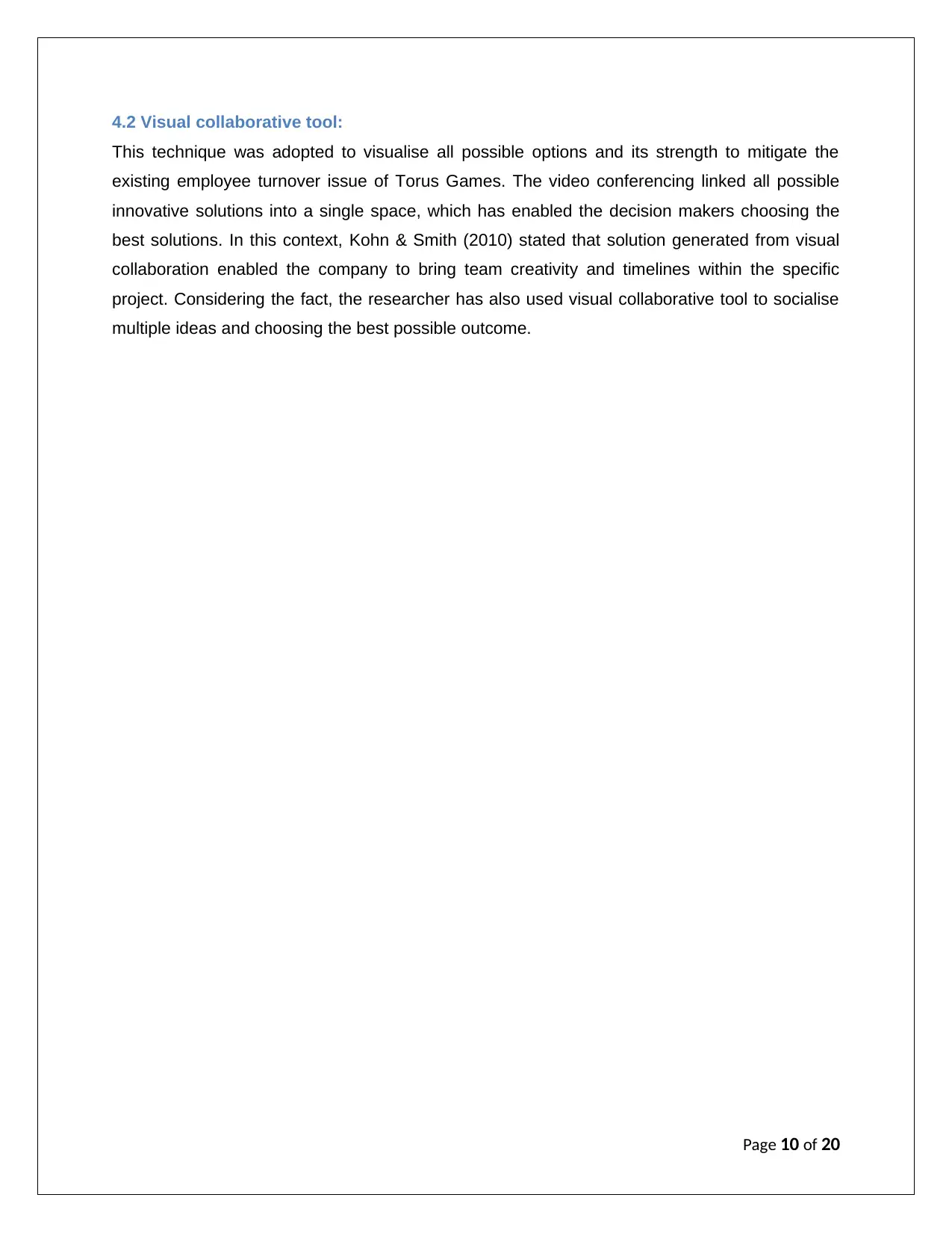
4.2 Visual collaborative tool:
This technique was adopted to visualise all possible options and its strength to mitigate the
existing employee turnover issue of Torus Games. The video conferencing linked all possible
innovative solutions into a single space, which has enabled the decision makers choosing the
best solutions. In this context, Kohn & Smith (2010) stated that solution generated from visual
collaboration enabled the company to bring team creativity and timelines within the specific
project. Considering the fact, the researcher has also used visual collaborative tool to socialise
multiple ideas and choosing the best possible outcome.
Page 10 of 20
This technique was adopted to visualise all possible options and its strength to mitigate the
existing employee turnover issue of Torus Games. The video conferencing linked all possible
innovative solutions into a single space, which has enabled the decision makers choosing the
best solutions. In this context, Kohn & Smith (2010) stated that solution generated from visual
collaboration enabled the company to bring team creativity and timelines within the specific
project. Considering the fact, the researcher has also used visual collaborative tool to socialise
multiple ideas and choosing the best possible outcome.
Page 10 of 20
Secure Best Marks with AI Grader
Need help grading? Try our AI Grader for instant feedback on your assignments.
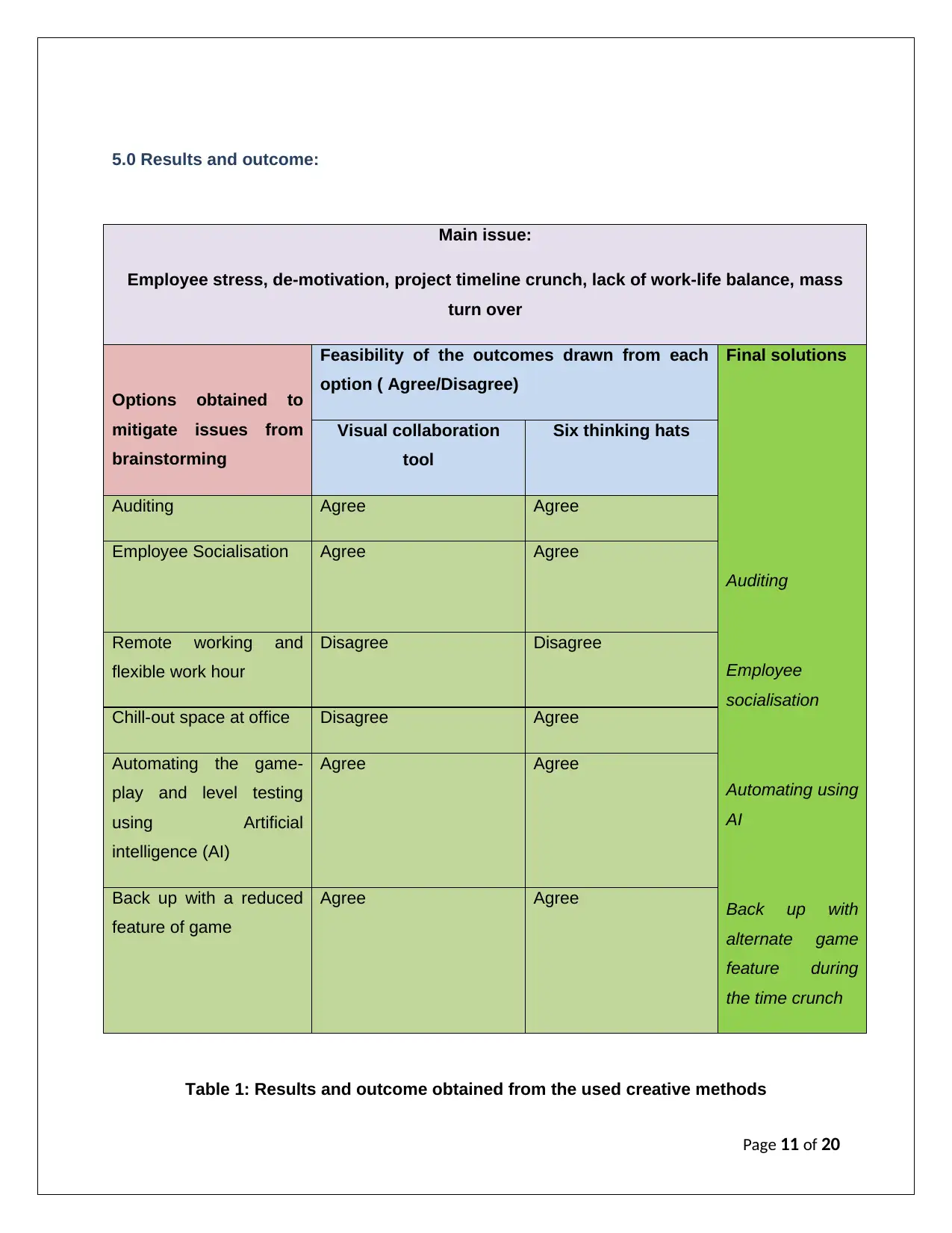
5.0 Results and outcome:
Main issue:
Employee stress, de-motivation, project timeline crunch, lack of work-life balance, mass
turn over
Options obtained to
mitigate issues from
brainstorming
Feasibility of the outcomes drawn from each
option ( Agree/Disagree)
Final solutions
Auditing
Employee
socialisation
Automating using
AI
Back up with
alternate game
feature during
the time crunch
Visual collaboration
tool
Six thinking hats
Auditing Agree Agree
Employee Socialisation Agree Agree
Remote working and
flexible work hour
Disagree Disagree
Chill-out space at office Disagree Agree
Automating the game-
play and level testing
using Artificial
intelligence (AI)
Agree Agree
Back up with a reduced
feature of game
Agree Agree
Table 1: Results and outcome obtained from the used creative methods
Page 11 of 20
Main issue:
Employee stress, de-motivation, project timeline crunch, lack of work-life balance, mass
turn over
Options obtained to
mitigate issues from
brainstorming
Feasibility of the outcomes drawn from each
option ( Agree/Disagree)
Final solutions
Auditing
Employee
socialisation
Automating using
AI
Back up with
alternate game
feature during
the time crunch
Visual collaboration
tool
Six thinking hats
Auditing Agree Agree
Employee Socialisation Agree Agree
Remote working and
flexible work hour
Disagree Disagree
Chill-out space at office Disagree Agree
Automating the game-
play and level testing
using Artificial
intelligence (AI)
Agree Agree
Back up with a reduced
feature of game
Agree Agree
Table 1: Results and outcome obtained from the used creative methods
Page 11 of 20
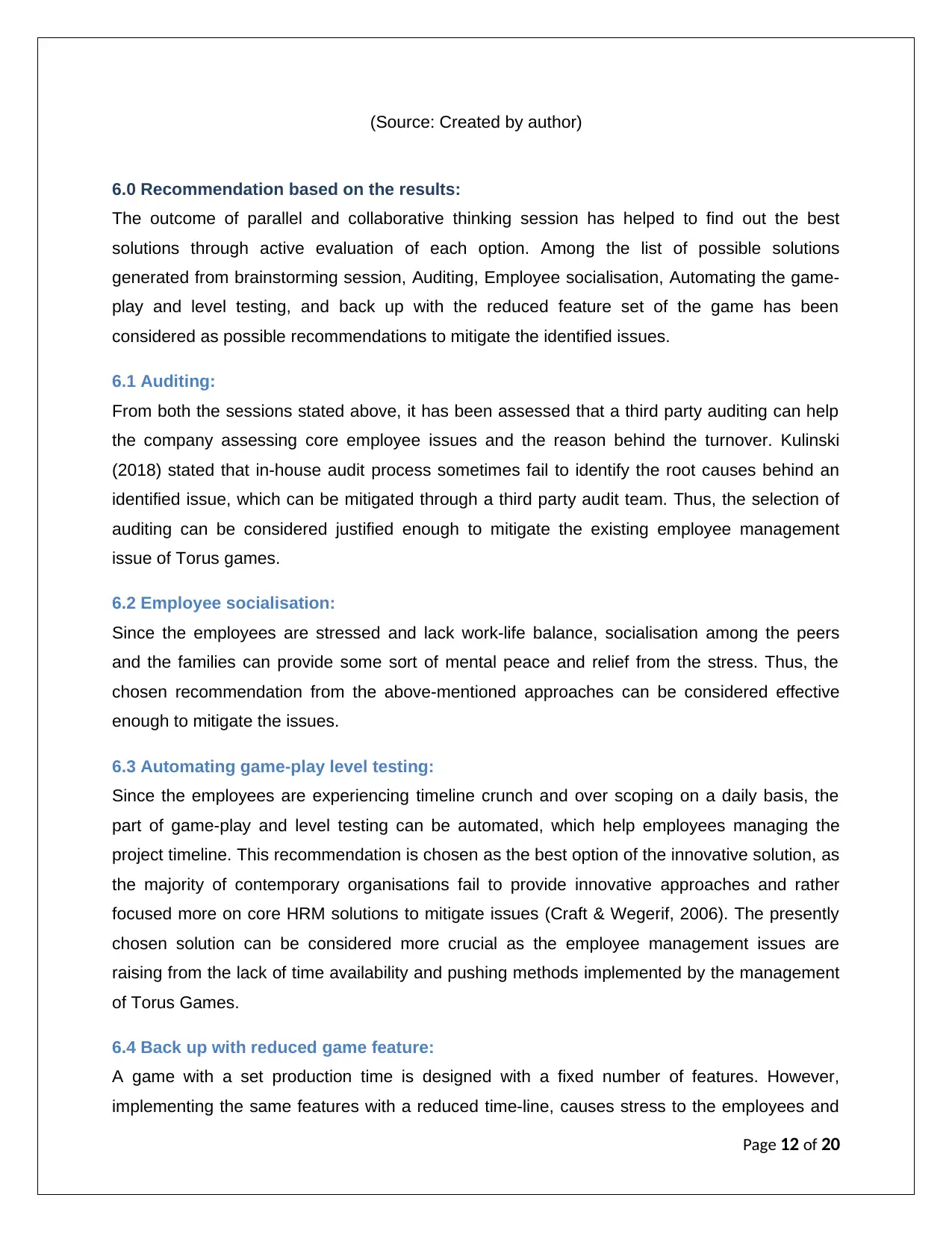
(Source: Created by author)
6.0 Recommendation based on the results:
The outcome of parallel and collaborative thinking session has helped to find out the best
solutions through active evaluation of each option. Among the list of possible solutions
generated from brainstorming session, Auditing, Employee socialisation, Automating the game-
play and level testing, and back up with the reduced feature set of the game has been
considered as possible recommendations to mitigate the identified issues.
6.1 Auditing:
From both the sessions stated above, it has been assessed that a third party auditing can help
the company assessing core employee issues and the reason behind the turnover. Kulinski
(2018) stated that in-house audit process sometimes fail to identify the root causes behind an
identified issue, which can be mitigated through a third party audit team. Thus, the selection of
auditing can be considered justified enough to mitigate the existing employee management
issue of Torus games.
6.2 Employee socialisation:
Since the employees are stressed and lack work-life balance, socialisation among the peers
and the families can provide some sort of mental peace and relief from the stress. Thus, the
chosen recommendation from the above-mentioned approaches can be considered effective
enough to mitigate the issues.
6.3 Automating game-play level testing:
Since the employees are experiencing timeline crunch and over scoping on a daily basis, the
part of game-play and level testing can be automated, which help employees managing the
project timeline. This recommendation is chosen as the best option of the innovative solution, as
the majority of contemporary organisations fail to provide innovative approaches and rather
focused more on core HRM solutions to mitigate issues (Craft & Wegerif, 2006). The presently
chosen solution can be considered more crucial as the employee management issues are
raising from the lack of time availability and pushing methods implemented by the management
of Torus Games.
6.4 Back up with reduced game feature:
A game with a set production time is designed with a fixed number of features. However,
implementing the same features with a reduced time-line, causes stress to the employees and
Page 12 of 20
6.0 Recommendation based on the results:
The outcome of parallel and collaborative thinking session has helped to find out the best
solutions through active evaluation of each option. Among the list of possible solutions
generated from brainstorming session, Auditing, Employee socialisation, Automating the game-
play and level testing, and back up with the reduced feature set of the game has been
considered as possible recommendations to mitigate the identified issues.
6.1 Auditing:
From both the sessions stated above, it has been assessed that a third party auditing can help
the company assessing core employee issues and the reason behind the turnover. Kulinski
(2018) stated that in-house audit process sometimes fail to identify the root causes behind an
identified issue, which can be mitigated through a third party audit team. Thus, the selection of
auditing can be considered justified enough to mitigate the existing employee management
issue of Torus games.
6.2 Employee socialisation:
Since the employees are stressed and lack work-life balance, socialisation among the peers
and the families can provide some sort of mental peace and relief from the stress. Thus, the
chosen recommendation from the above-mentioned approaches can be considered effective
enough to mitigate the issues.
6.3 Automating game-play level testing:
Since the employees are experiencing timeline crunch and over scoping on a daily basis, the
part of game-play and level testing can be automated, which help employees managing the
project timeline. This recommendation is chosen as the best option of the innovative solution, as
the majority of contemporary organisations fail to provide innovative approaches and rather
focused more on core HRM solutions to mitigate issues (Craft & Wegerif, 2006). The presently
chosen solution can be considered more crucial as the employee management issues are
raising from the lack of time availability and pushing methods implemented by the management
of Torus Games.
6.4 Back up with reduced game feature:
A game with a set production time is designed with a fixed number of features. However,
implementing the same features with a reduced time-line, causes stress to the employees and
Page 12 of 20
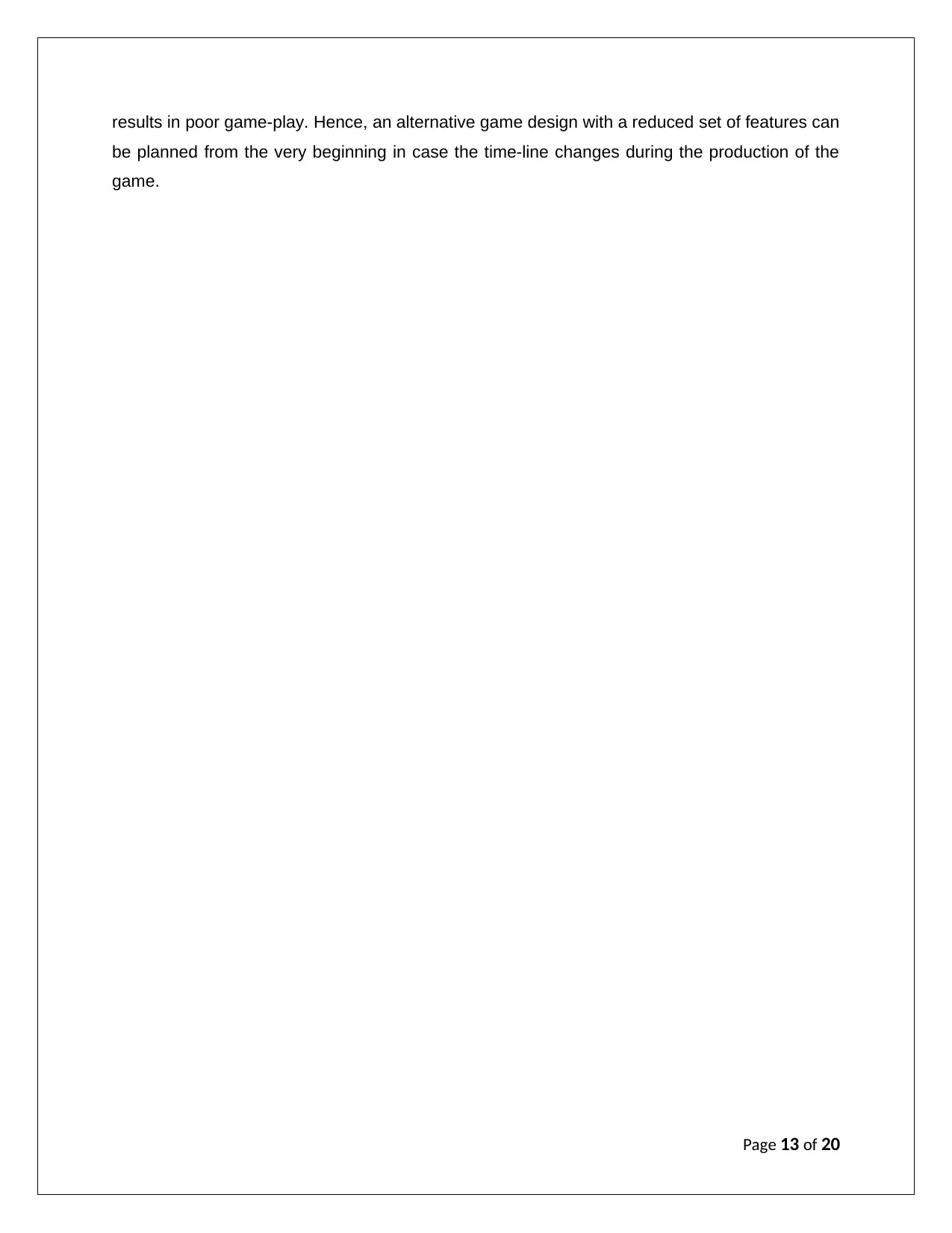
results in poor game-play. Hence, an alternative game design with a reduced set of features can
be planned from the very beginning in case the time-line changes during the production of the
game.
Page 13 of 20
be planned from the very beginning in case the time-line changes during the production of the
game.
Page 13 of 20
Paraphrase This Document
Need a fresh take? Get an instant paraphrase of this document with our AI Paraphraser
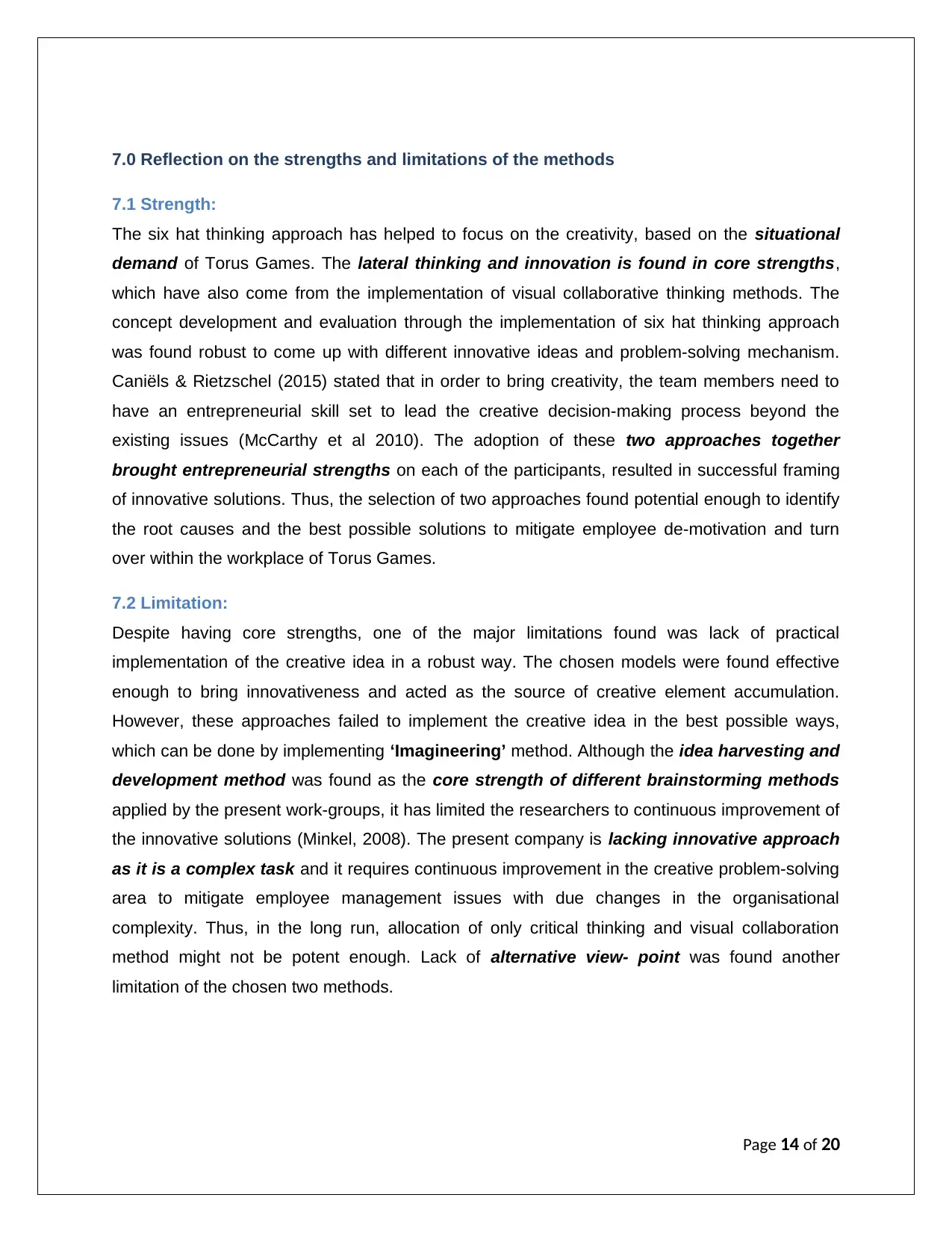
7.0 Reflection on the strengths and limitations of the methods
7.1 Strength:
The six hat thinking approach has helped to focus on the creativity, based on the situational
demand of Torus Games. The lateral thinking and innovation is found in core strengths,
which have also come from the implementation of visual collaborative thinking methods. The
concept development and evaluation through the implementation of six hat thinking approach
was found robust to come up with different innovative ideas and problem-solving mechanism.
Caniëls & Rietzschel (2015) stated that in order to bring creativity, the team members need to
have an entrepreneurial skill set to lead the creative decision-making process beyond the
existing issues (McCarthy et al 2010). The adoption of these two approaches together
brought entrepreneurial strengths on each of the participants, resulted in successful framing
of innovative solutions. Thus, the selection of two approaches found potential enough to identify
the root causes and the best possible solutions to mitigate employee de-motivation and turn
over within the workplace of Torus Games.
7.2 Limitation:
Despite having core strengths, one of the major limitations found was lack of practical
implementation of the creative idea in a robust way. The chosen models were found effective
enough to bring innovativeness and acted as the source of creative element accumulation.
However, these approaches failed to implement the creative idea in the best possible ways,
which can be done by implementing ‘Imagineering’ method. Although the idea harvesting and
development method was found as the core strength of different brainstorming methods
applied by the present work-groups, it has limited the researchers to continuous improvement of
the innovative solutions (Minkel, 2008). The present company is lacking innovative approach
as it is a complex task and it requires continuous improvement in the creative problem-solving
area to mitigate employee management issues with due changes in the organisational
complexity. Thus, in the long run, allocation of only critical thinking and visual collaboration
method might not be potent enough. Lack of alternative view- point was found another
limitation of the chosen two methods.
Page 14 of 20
7.1 Strength:
The six hat thinking approach has helped to focus on the creativity, based on the situational
demand of Torus Games. The lateral thinking and innovation is found in core strengths,
which have also come from the implementation of visual collaborative thinking methods. The
concept development and evaluation through the implementation of six hat thinking approach
was found robust to come up with different innovative ideas and problem-solving mechanism.
Caniëls & Rietzschel (2015) stated that in order to bring creativity, the team members need to
have an entrepreneurial skill set to lead the creative decision-making process beyond the
existing issues (McCarthy et al 2010). The adoption of these two approaches together
brought entrepreneurial strengths on each of the participants, resulted in successful framing
of innovative solutions. Thus, the selection of two approaches found potential enough to identify
the root causes and the best possible solutions to mitigate employee de-motivation and turn
over within the workplace of Torus Games.
7.2 Limitation:
Despite having core strengths, one of the major limitations found was lack of practical
implementation of the creative idea in a robust way. The chosen models were found effective
enough to bring innovativeness and acted as the source of creative element accumulation.
However, these approaches failed to implement the creative idea in the best possible ways,
which can be done by implementing ‘Imagineering’ method. Although the idea harvesting and
development method was found as the core strength of different brainstorming methods
applied by the present work-groups, it has limited the researchers to continuous improvement of
the innovative solutions (Minkel, 2008). The present company is lacking innovative approach
as it is a complex task and it requires continuous improvement in the creative problem-solving
area to mitigate employee management issues with due changes in the organisational
complexity. Thus, in the long run, allocation of only critical thinking and visual collaboration
method might not be potent enough. Lack of alternative view- point was found another
limitation of the chosen two methods.
Page 14 of 20
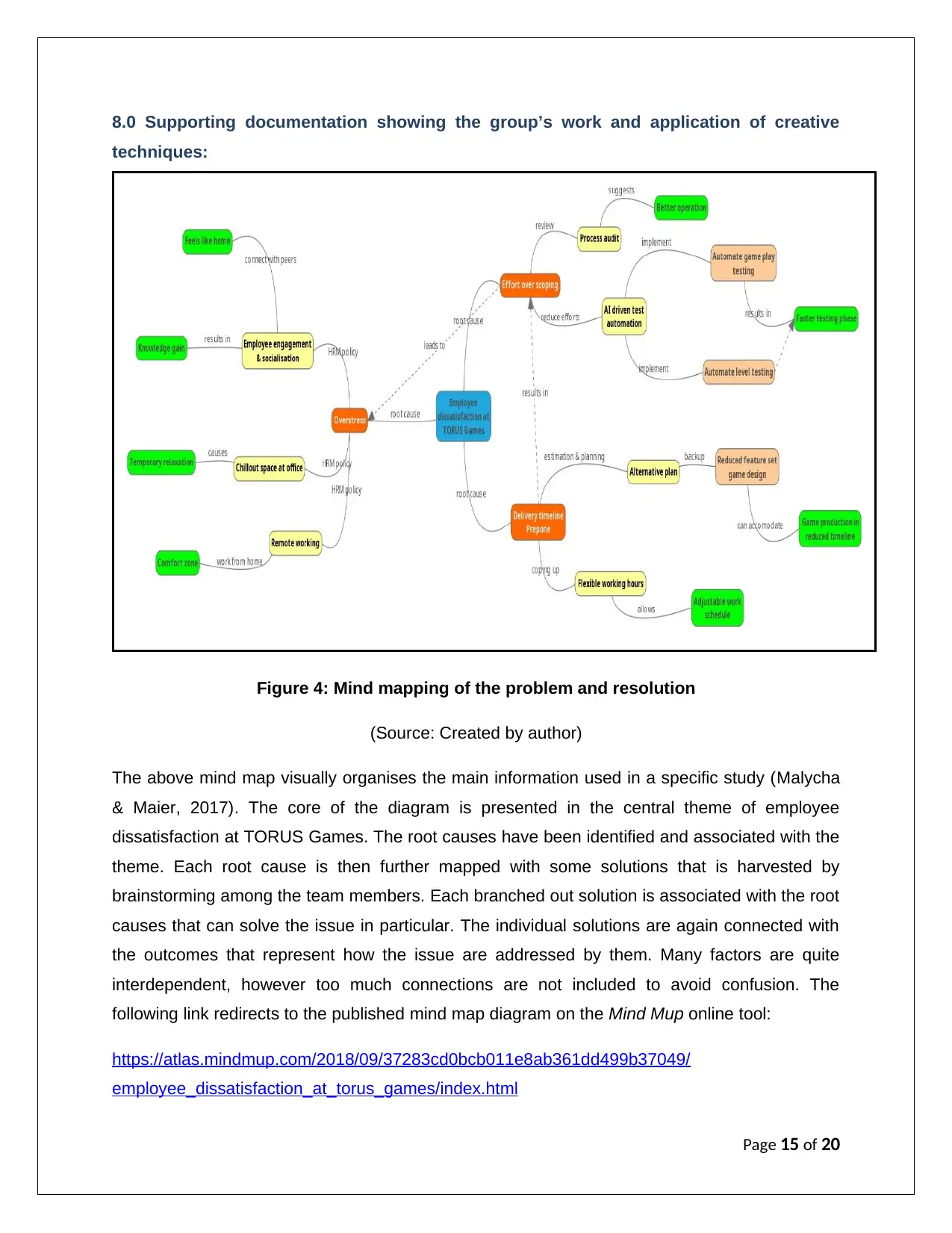
8.0 Supporting documentation showing the group’s work and application of creative
techniques:
Figure 4: Mind mapping of the problem and resolution
(Source: Created by author)
The above mind map visually organises the main information used in a specific study (Malycha
& Maier, 2017). The core of the diagram is presented in the central theme of employee
dissatisfaction at TORUS Games. The root causes have been identified and associated with the
theme. Each root cause is then further mapped with some solutions that is harvested by
brainstorming among the team members. Each branched out solution is associated with the root
causes that can solve the issue in particular. The individual solutions are again connected with
the outcomes that represent how the issue are addressed by them. Many factors are quite
interdependent, however too much connections are not included to avoid confusion. The
following link redirects to the published mind map diagram on the Mind Mup online tool:
https://atlas.mindmup.com/2018/09/37283cd0bcb011e8ab361dd499b37049/
employee_dissatisfaction_at_torus_games/index.html
Page 15 of 20
techniques:
Figure 4: Mind mapping of the problem and resolution
(Source: Created by author)
The above mind map visually organises the main information used in a specific study (Malycha
& Maier, 2017). The core of the diagram is presented in the central theme of employee
dissatisfaction at TORUS Games. The root causes have been identified and associated with the
theme. Each root cause is then further mapped with some solutions that is harvested by
brainstorming among the team members. Each branched out solution is associated with the root
causes that can solve the issue in particular. The individual solutions are again connected with
the outcomes that represent how the issue are addressed by them. Many factors are quite
interdependent, however too much connections are not included to avoid confusion. The
following link redirects to the published mind map diagram on the Mind Mup online tool:
https://atlas.mindmup.com/2018/09/37283cd0bcb011e8ab361dd499b37049/
employee_dissatisfaction_at_torus_games/index.html
Page 15 of 20
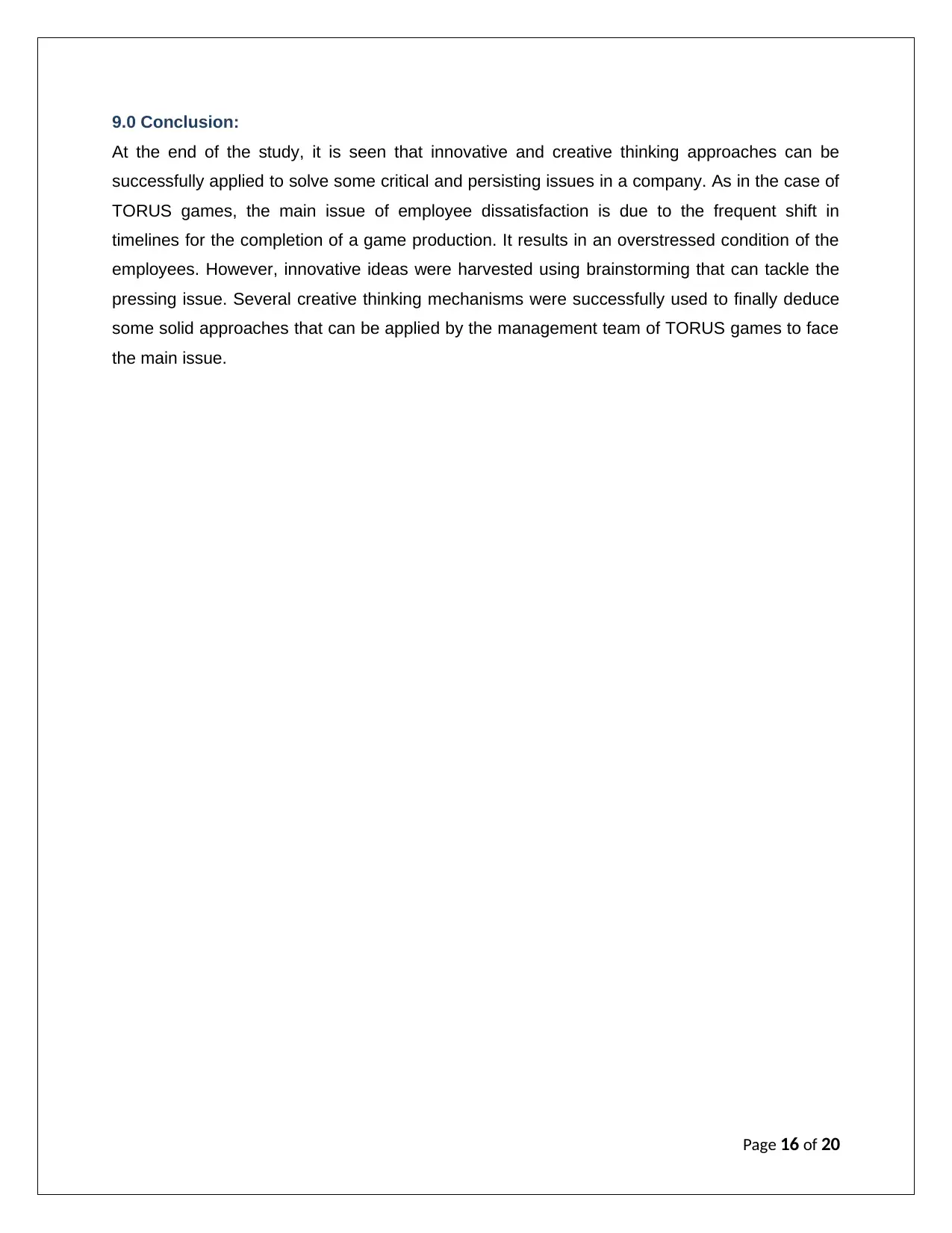
9.0 Conclusion:
At the end of the study, it is seen that innovative and creative thinking approaches can be
successfully applied to solve some critical and persisting issues in a company. As in the case of
TORUS games, the main issue of employee dissatisfaction is due to the frequent shift in
timelines for the completion of a game production. It results in an overstressed condition of the
employees. However, innovative ideas were harvested using brainstorming that can tackle the
pressing issue. Several creative thinking mechanisms were successfully used to finally deduce
some solid approaches that can be applied by the management team of TORUS games to face
the main issue.
Page 16 of 20
At the end of the study, it is seen that innovative and creative thinking approaches can be
successfully applied to solve some critical and persisting issues in a company. As in the case of
TORUS games, the main issue of employee dissatisfaction is due to the frequent shift in
timelines for the completion of a game production. It results in an overstressed condition of the
employees. However, innovative ideas were harvested using brainstorming that can tackle the
pressing issue. Several creative thinking mechanisms were successfully used to finally deduce
some solid approaches that can be applied by the management team of TORUS games to face
the main issue.
Page 16 of 20
Secure Best Marks with AI Grader
Need help grading? Try our AI Grader for instant feedback on your assignments.
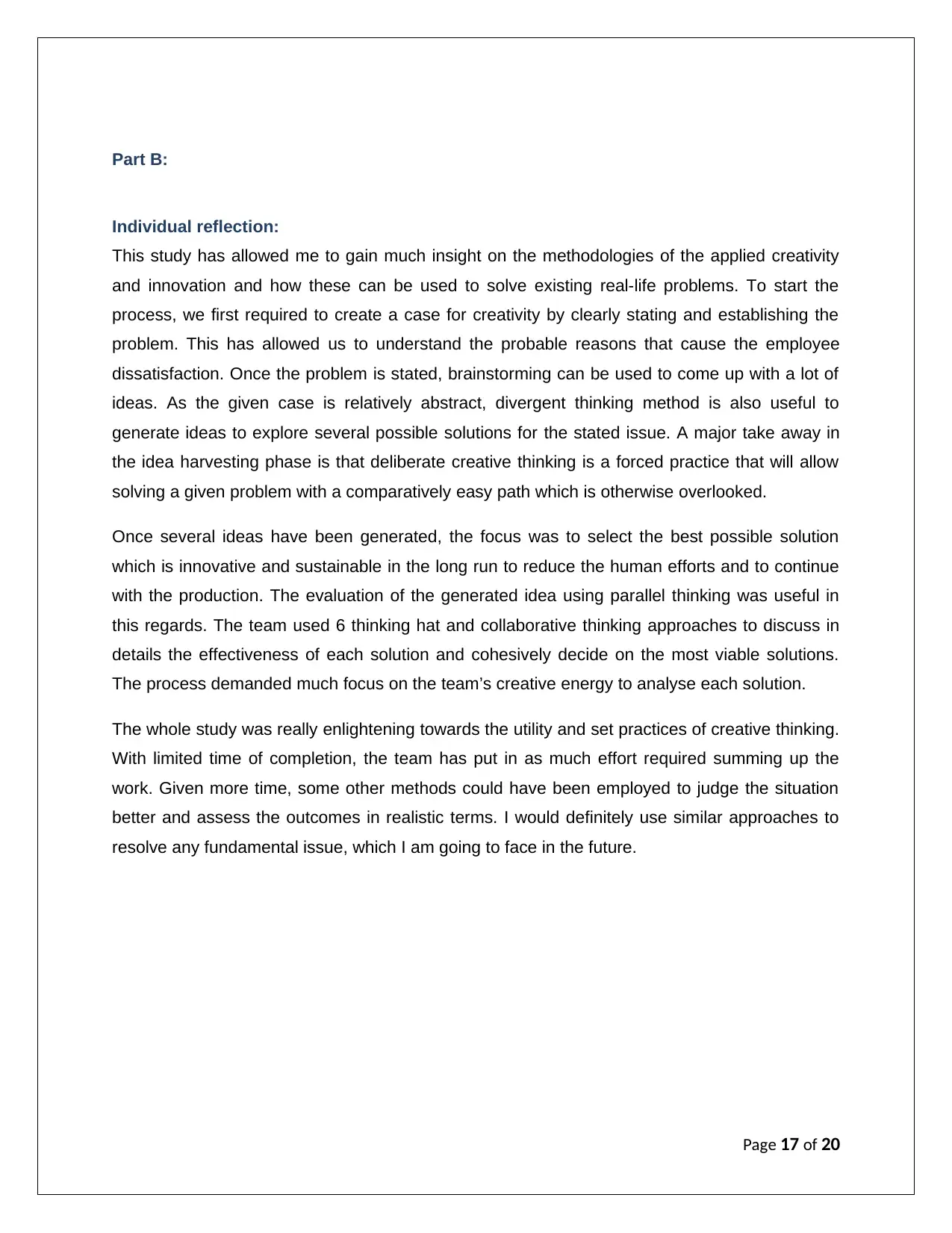
Part B:
Individual reflection:
This study has allowed me to gain much insight on the methodologies of the applied creativity
and innovation and how these can be used to solve existing real-life problems. To start the
process, we first required to create a case for creativity by clearly stating and establishing the
problem. This has allowed us to understand the probable reasons that cause the employee
dissatisfaction. Once the problem is stated, brainstorming can be used to come up with a lot of
ideas. As the given case is relatively abstract, divergent thinking method is also useful to
generate ideas to explore several possible solutions for the stated issue. A major take away in
the idea harvesting phase is that deliberate creative thinking is a forced practice that will allow
solving a given problem with a comparatively easy path which is otherwise overlooked.
Once several ideas have been generated, the focus was to select the best possible solution
which is innovative and sustainable in the long run to reduce the human efforts and to continue
with the production. The evaluation of the generated idea using parallel thinking was useful in
this regards. The team used 6 thinking hat and collaborative thinking approaches to discuss in
details the effectiveness of each solution and cohesively decide on the most viable solutions.
The process demanded much focus on the team’s creative energy to analyse each solution.
The whole study was really enlightening towards the utility and set practices of creative thinking.
With limited time of completion, the team has put in as much effort required summing up the
work. Given more time, some other methods could have been employed to judge the situation
better and assess the outcomes in realistic terms. I would definitely use similar approaches to
resolve any fundamental issue, which I am going to face in the future.
Page 17 of 20
Individual reflection:
This study has allowed me to gain much insight on the methodologies of the applied creativity
and innovation and how these can be used to solve existing real-life problems. To start the
process, we first required to create a case for creativity by clearly stating and establishing the
problem. This has allowed us to understand the probable reasons that cause the employee
dissatisfaction. Once the problem is stated, brainstorming can be used to come up with a lot of
ideas. As the given case is relatively abstract, divergent thinking method is also useful to
generate ideas to explore several possible solutions for the stated issue. A major take away in
the idea harvesting phase is that deliberate creative thinking is a forced practice that will allow
solving a given problem with a comparatively easy path which is otherwise overlooked.
Once several ideas have been generated, the focus was to select the best possible solution
which is innovative and sustainable in the long run to reduce the human efforts and to continue
with the production. The evaluation of the generated idea using parallel thinking was useful in
this regards. The team used 6 thinking hat and collaborative thinking approaches to discuss in
details the effectiveness of each solution and cohesively decide on the most viable solutions.
The process demanded much focus on the team’s creative energy to analyse each solution.
The whole study was really enlightening towards the utility and set practices of creative thinking.
With limited time of completion, the team has put in as much effort required summing up the
work. Given more time, some other methods could have been employed to judge the situation
better and assess the outcomes in realistic terms. I would definitely use similar approaches to
resolve any fundamental issue, which I am going to face in the future.
Page 17 of 20
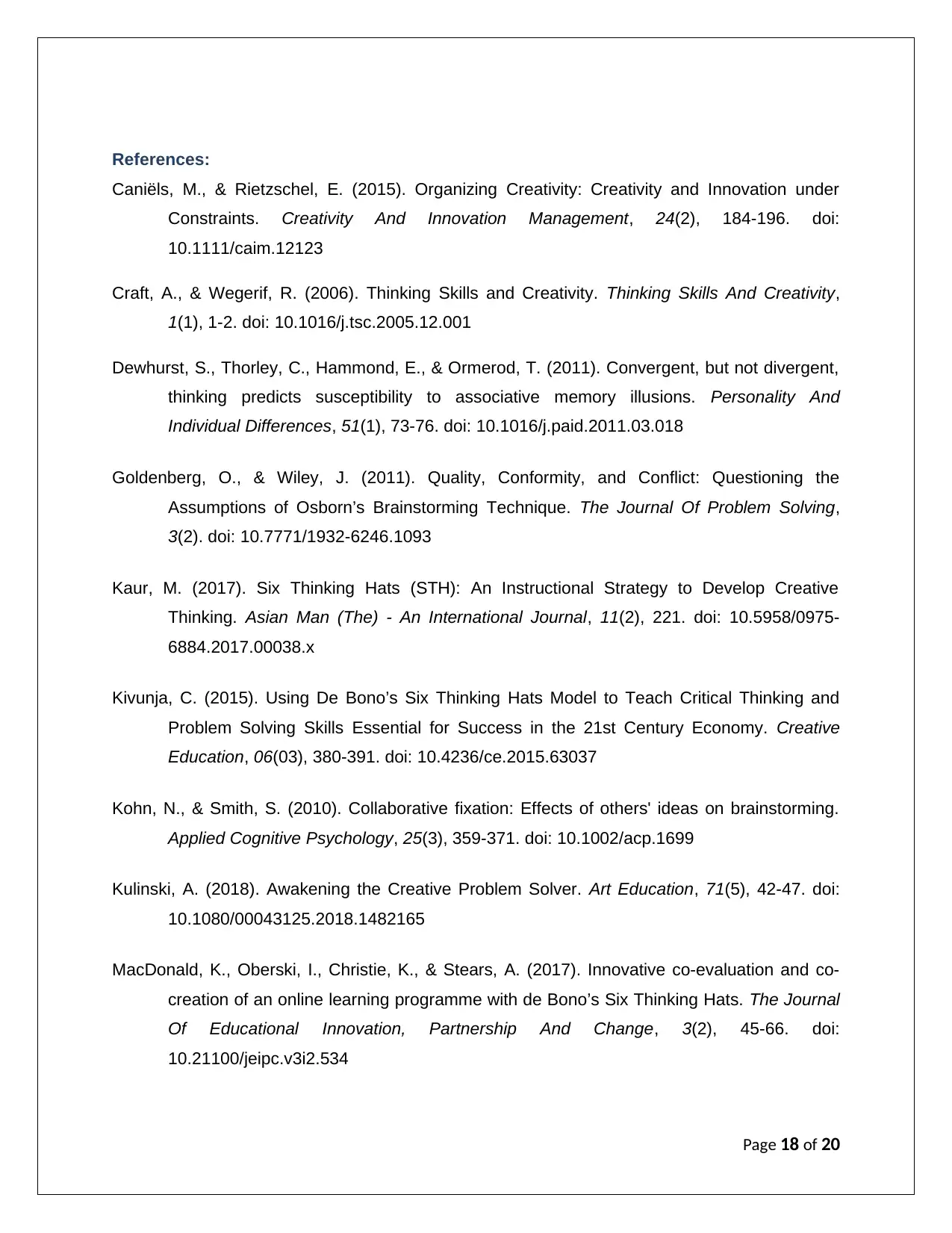
References:
Caniëls, M., & Rietzschel, E. (2015). Organizing Creativity: Creativity and Innovation under
Constraints. Creativity And Innovation Management, 24(2), 184-196. doi:
10.1111/caim.12123
Craft, A., & Wegerif, R. (2006). Thinking Skills and Creativity. Thinking Skills And Creativity,
1(1), 1-2. doi: 10.1016/j.tsc.2005.12.001
Dewhurst, S., Thorley, C., Hammond, E., & Ormerod, T. (2011). Convergent, but not divergent,
thinking predicts susceptibility to associative memory illusions. Personality And
Individual Differences, 51(1), 73-76. doi: 10.1016/j.paid.2011.03.018
Goldenberg, O., & Wiley, J. (2011). Quality, Conformity, and Conflict: Questioning the
Assumptions of Osborn’s Brainstorming Technique. The Journal Of Problem Solving,
3(2). doi: 10.7771/1932-6246.1093
Kaur, M. (2017). Six Thinking Hats (STH): An Instructional Strategy to Develop Creative
Thinking. Asian Man (The) - An International Journal, 11(2), 221. doi: 10.5958/0975-
6884.2017.00038.x
Kivunja, C. (2015). Using De Bono’s Six Thinking Hats Model to Teach Critical Thinking and
Problem Solving Skills Essential for Success in the 21st Century Economy. Creative
Education, 06(03), 380-391. doi: 10.4236/ce.2015.63037
Kohn, N., & Smith, S. (2010). Collaborative fixation: Effects of others' ideas on brainstorming.
Applied Cognitive Psychology, 25(3), 359-371. doi: 10.1002/acp.1699
Kulinski, A. (2018). Awakening the Creative Problem Solver. Art Education, 71(5), 42-47. doi:
10.1080/00043125.2018.1482165
MacDonald, K., Oberski, I., Christie, K., & Stears, A. (2017). Innovative co-evaluation and co-
creation of an online learning programme with de Bono’s Six Thinking Hats. The Journal
Of Educational Innovation, Partnership And Change, 3(2), 45-66. doi:
10.21100/jeipc.v3i2.534
Page 18 of 20
Caniëls, M., & Rietzschel, E. (2015). Organizing Creativity: Creativity and Innovation under
Constraints. Creativity And Innovation Management, 24(2), 184-196. doi:
10.1111/caim.12123
Craft, A., & Wegerif, R. (2006). Thinking Skills and Creativity. Thinking Skills And Creativity,
1(1), 1-2. doi: 10.1016/j.tsc.2005.12.001
Dewhurst, S., Thorley, C., Hammond, E., & Ormerod, T. (2011). Convergent, but not divergent,
thinking predicts susceptibility to associative memory illusions. Personality And
Individual Differences, 51(1), 73-76. doi: 10.1016/j.paid.2011.03.018
Goldenberg, O., & Wiley, J. (2011). Quality, Conformity, and Conflict: Questioning the
Assumptions of Osborn’s Brainstorming Technique. The Journal Of Problem Solving,
3(2). doi: 10.7771/1932-6246.1093
Kaur, M. (2017). Six Thinking Hats (STH): An Instructional Strategy to Develop Creative
Thinking. Asian Man (The) - An International Journal, 11(2), 221. doi: 10.5958/0975-
6884.2017.00038.x
Kivunja, C. (2015). Using De Bono’s Six Thinking Hats Model to Teach Critical Thinking and
Problem Solving Skills Essential for Success in the 21st Century Economy. Creative
Education, 06(03), 380-391. doi: 10.4236/ce.2015.63037
Kohn, N., & Smith, S. (2010). Collaborative fixation: Effects of others' ideas on brainstorming.
Applied Cognitive Psychology, 25(3), 359-371. doi: 10.1002/acp.1699
Kulinski, A. (2018). Awakening the Creative Problem Solver. Art Education, 71(5), 42-47. doi:
10.1080/00043125.2018.1482165
MacDonald, K., Oberski, I., Christie, K., & Stears, A. (2017). Innovative co-evaluation and co-
creation of an online learning programme with de Bono’s Six Thinking Hats. The Journal
Of Educational Innovation, Partnership And Change, 3(2), 45-66. doi:
10.21100/jeipc.v3i2.534
Page 18 of 20
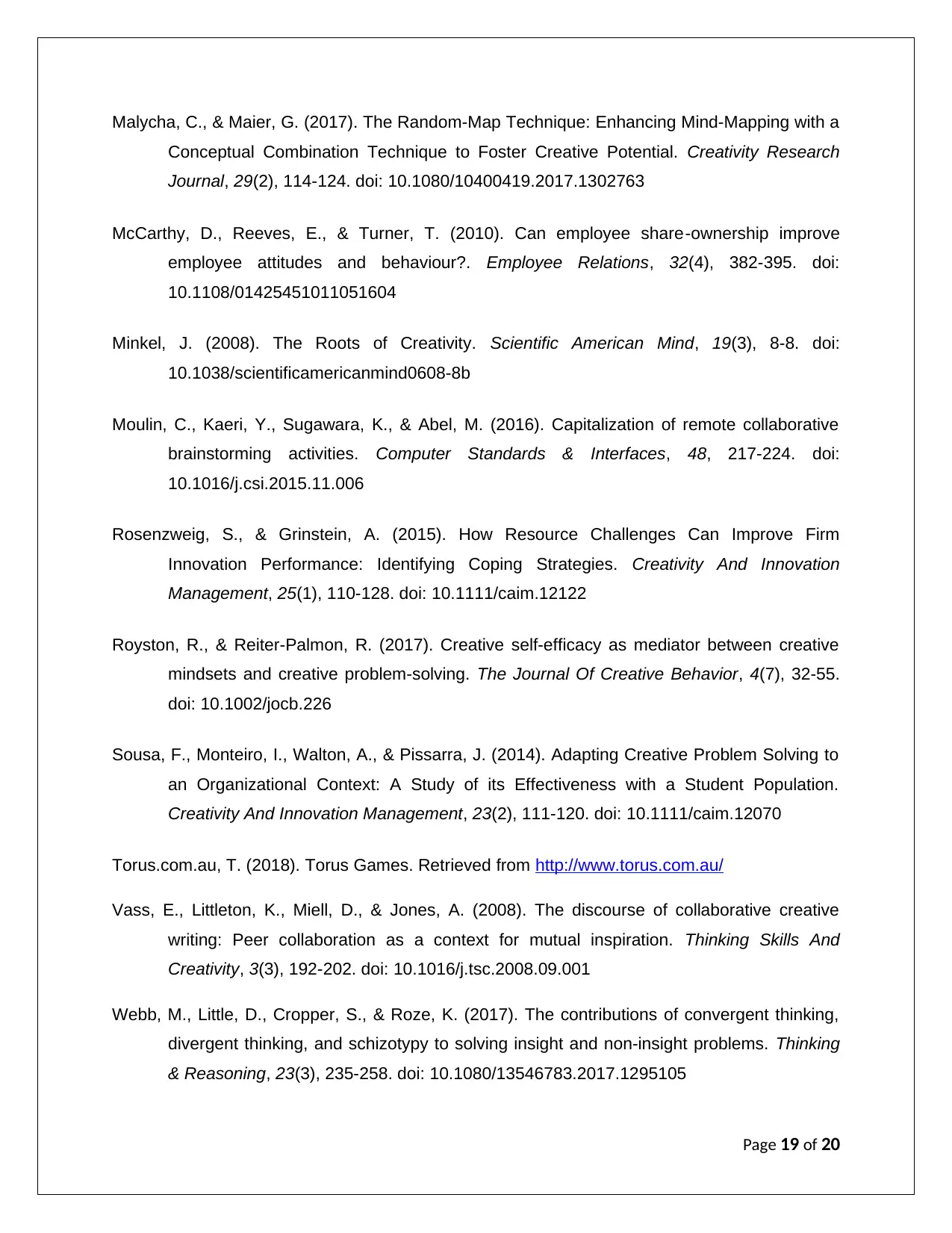
Malycha, C., & Maier, G. (2017). The Random-Map Technique: Enhancing Mind-Mapping with a
Conceptual Combination Technique to Foster Creative Potential. Creativity Research
Journal, 29(2), 114-124. doi: 10.1080/10400419.2017.1302763
McCarthy, D., Reeves, E., & Turner, T. (2010). Can employee share‐ownership improve
employee attitudes and behaviour?. Employee Relations, 32(4), 382-395. doi:
10.1108/01425451011051604
Minkel, J. (2008). The Roots of Creativity. Scientific American Mind, 19(3), 8-8. doi:
10.1038/scientificamericanmind0608-8b
Moulin, C., Kaeri, Y., Sugawara, K., & Abel, M. (2016). Capitalization of remote collaborative
brainstorming activities. Computer Standards & Interfaces, 48, 217-224. doi:
10.1016/j.csi.2015.11.006
Rosenzweig, S., & Grinstein, A. (2015). How Resource Challenges Can Improve Firm
Innovation Performance: Identifying Coping Strategies. Creativity And Innovation
Management, 25(1), 110-128. doi: 10.1111/caim.12122
Royston, R., & Reiter-Palmon, R. (2017). Creative self-efficacy as mediator between creative
mindsets and creative problem-solving. The Journal Of Creative Behavior, 4(7), 32-55.
doi: 10.1002/jocb.226
Sousa, F., Monteiro, I., Walton, A., & Pissarra, J. (2014). Adapting Creative Problem Solving to
an Organizational Context: A Study of its Effectiveness with a Student Population.
Creativity And Innovation Management, 23(2), 111-120. doi: 10.1111/caim.12070
Torus.com.au, T. (2018). Torus Games. Retrieved from http://www.torus.com.au/
Vass, E., Littleton, K., Miell, D., & Jones, A. (2008). The discourse of collaborative creative
writing: Peer collaboration as a context for mutual inspiration. Thinking Skills And
Creativity, 3(3), 192-202. doi: 10.1016/j.tsc.2008.09.001
Webb, M., Little, D., Cropper, S., & Roze, K. (2017). The contributions of convergent thinking,
divergent thinking, and schizotypy to solving insight and non-insight problems. Thinking
& Reasoning, 23(3), 235-258. doi: 10.1080/13546783.2017.1295105
Page 19 of 20
Conceptual Combination Technique to Foster Creative Potential. Creativity Research
Journal, 29(2), 114-124. doi: 10.1080/10400419.2017.1302763
McCarthy, D., Reeves, E., & Turner, T. (2010). Can employee share‐ownership improve
employee attitudes and behaviour?. Employee Relations, 32(4), 382-395. doi:
10.1108/01425451011051604
Minkel, J. (2008). The Roots of Creativity. Scientific American Mind, 19(3), 8-8. doi:
10.1038/scientificamericanmind0608-8b
Moulin, C., Kaeri, Y., Sugawara, K., & Abel, M. (2016). Capitalization of remote collaborative
brainstorming activities. Computer Standards & Interfaces, 48, 217-224. doi:
10.1016/j.csi.2015.11.006
Rosenzweig, S., & Grinstein, A. (2015). How Resource Challenges Can Improve Firm
Innovation Performance: Identifying Coping Strategies. Creativity And Innovation
Management, 25(1), 110-128. doi: 10.1111/caim.12122
Royston, R., & Reiter-Palmon, R. (2017). Creative self-efficacy as mediator between creative
mindsets and creative problem-solving. The Journal Of Creative Behavior, 4(7), 32-55.
doi: 10.1002/jocb.226
Sousa, F., Monteiro, I., Walton, A., & Pissarra, J. (2014). Adapting Creative Problem Solving to
an Organizational Context: A Study of its Effectiveness with a Student Population.
Creativity And Innovation Management, 23(2), 111-120. doi: 10.1111/caim.12070
Torus.com.au, T. (2018). Torus Games. Retrieved from http://www.torus.com.au/
Vass, E., Littleton, K., Miell, D., & Jones, A. (2008). The discourse of collaborative creative
writing: Peer collaboration as a context for mutual inspiration. Thinking Skills And
Creativity, 3(3), 192-202. doi: 10.1016/j.tsc.2008.09.001
Webb, M., Little, D., Cropper, S., & Roze, K. (2017). The contributions of convergent thinking,
divergent thinking, and schizotypy to solving insight and non-insight problems. Thinking
& Reasoning, 23(3), 235-258. doi: 10.1080/13546783.2017.1295105
Page 19 of 20
Paraphrase This Document
Need a fresh take? Get an instant paraphrase of this document with our AI Paraphraser
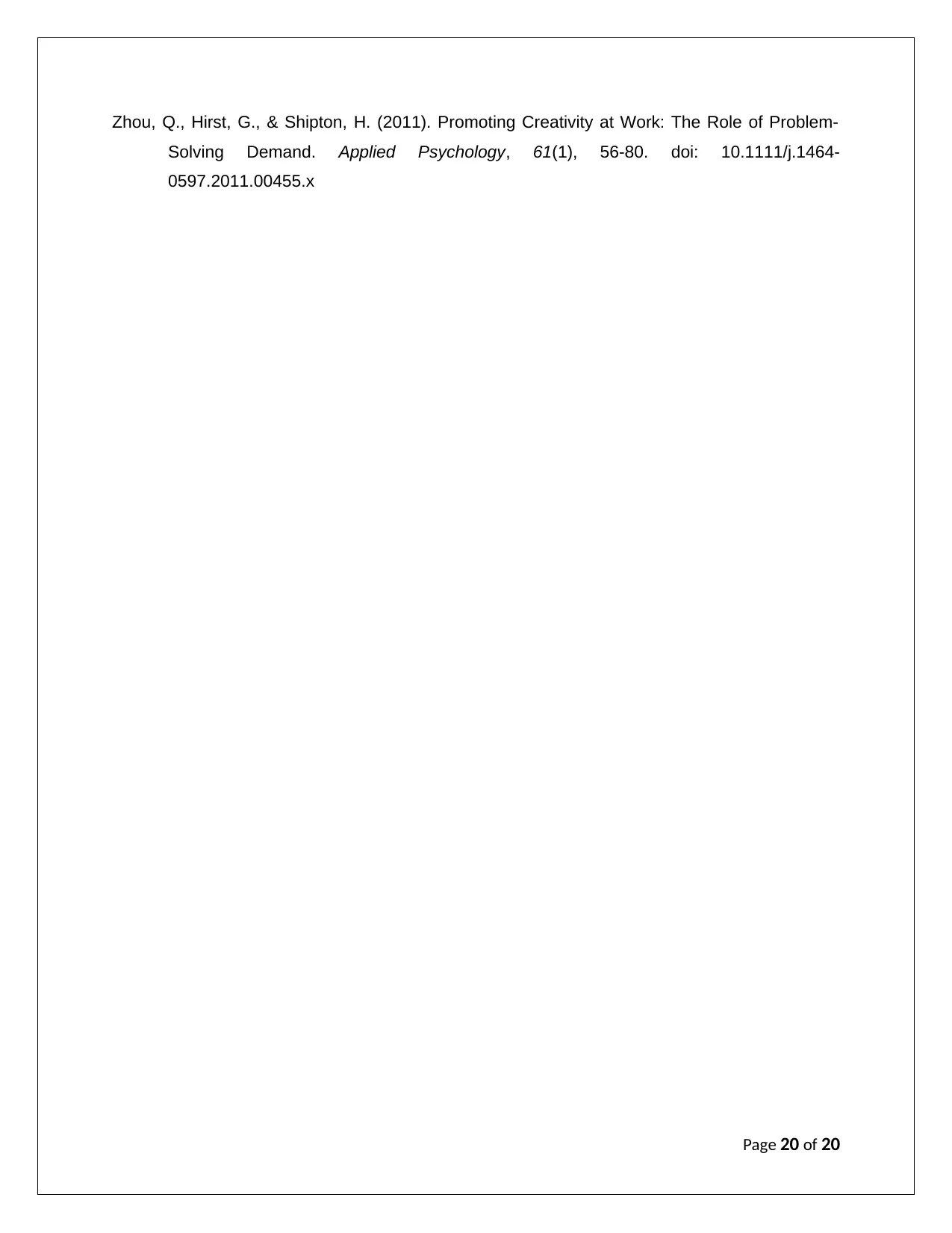
Zhou, Q., Hirst, G., & Shipton, H. (2011). Promoting Creativity at Work: The Role of Problem-
Solving Demand. Applied Psychology, 61(1), 56-80. doi: 10.1111/j.1464-
0597.2011.00455.x
Page 20 of 20
Solving Demand. Applied Psychology, 61(1), 56-80. doi: 10.1111/j.1464-
0597.2011.00455.x
Page 20 of 20
1 out of 20
Related Documents
Your All-in-One AI-Powered Toolkit for Academic Success.
+13062052269
info@desklib.com
Available 24*7 on WhatsApp / Email
![[object Object]](/_next/static/media/star-bottom.7253800d.svg)
Unlock your academic potential
© 2024 | Zucol Services PVT LTD | All rights reserved.




